

Pythagorean Theorem
How to Use The Pythagorean Theorem
The Formula
The picture below shows the formula for the Pythagorean theorem. For the purposes of the formula, side $$ \overline{c}$$ is always the hypotenuse . Remember that this formula only applies to right triangles .

Examples of the Pythagorean Theorem
When you use the Pythagorean theorem, just remember that the hypotenuse is always 'C' in the formula above. Look at the following examples to see pictures of the formula.

Conceptual Animation of Pythagorean Theorem
Demonstration #1.
More on the Pythagorean theorem
Demonstration #2
Video tutorial on how to use the pythagorean theorem.
Step By Step Examples of Using the Pythagorean Theorem
Example 1 (solving for the hypotenuse).
Use the Pythagorean theorem to determine the length of X.

Identify the legs and the hypotenuse of the right triangle .
The legs have length 6 and 8 . $$X $$ is the hypotenuse because it is opposite the right angle.

Substitute values into the formula (remember 'C' is the hypotenuse).
$ A^2+ B^2= \red C^2 \\ 6^2+ 8^2= \red X^2 $
$A^2+ B^2= \red X^2 \\ 100= \red X^2 \\ \sqrt {100} = \red X \\ 10= \red X $
Example 2 (solving for a Leg)

The legs have length 24 and $$X$$ are the legs. The hypotenuse is 26.

$ \red A^2+ B^2= C^2 \\ \red x^2 + 24^2= {26}^2 $
$ \red x^2 + 24^2= 26^2 \\ \red x^2 + 576= 676 \\ \red x^2 = 676 - 576 \\ \red x^2 = 100 \\ \red x = \sqrt { 100} \\ \red x = 10 $
Practice Problems
Find the length of X.

Remember our steps for how to use this theorem. This problems is like example 1 because we are solving for the hypotenuse .
The legs have length 14 and 48 . The hypotenuse is X.
$ A^2 + B^2 = C^2 \\ 14^2 + 48^2 = x^2 $
Solve for the unknown.
$ 14^2 + 48^2 = x^2 \\ 196 + 2304 = x^2 \\ \sqrt{2500} = x \\ \boxed{ 50 = x} $

Use the Pythagorean theorem to calculate the value of X. Round your answer to the nearest tenth.

Remember our steps for how to use this theorem. This problems is like example 2 because we are solving for one of the legs .
The legs have length 9 and X . The hypotenuse is 10.
$ A^2 + B^2 = C^2 \\ 9^2 + x^2 = 10^2 $
$ 9^2 + x^2 = 10^2 \\ 81 + x^2 = 100 \\ x^2 = 100 - 81 \\ x^2 = 19 \\ x = \sqrt{19} \approx 4.4 $
Use the Pythagorean theorem to calculate the value of X. Round your answer to the nearest hundredth.

The legs have length '10' and 'X'. The hypotenuse is 20.
$ A^2 + B^2 = C^2 \\ 10^2 + \red x^2 = 20^2 $
$ 10^2 + \red x^2 = 20^2 \\ 100 + \red x^2 = 400 \\ \red x^2 = 400 -100 \\ \red x^2 = 300 \\ \red x = \sqrt{300} \approx 17.32 $
- Pythagorean Theorem Shell Problem Cool challenging problem from involving pythagoren theorem, isosceles triangles and pattern recognition
- Free Triangle Worksheets
- Pythagorean Theorem Calculator
Ultimate Math Solver (Free) Free Algebra Solver ... type anything in there!
Popular pages @ mathwarehouse.com.


- school Campus Bookshelves
- menu_book Bookshelves
- perm_media Learning Objects
- login Login
- how_to_reg Request Instructor Account
- hub Instructor Commons
- Download Page (PDF)
- Download Full Book (PDF)
- Periodic Table
- Physics Constants
- Scientific Calculator
- Reference & Cite
- Tools expand_more
- Readability
selected template will load here
This action is not available.

7.4: The Pythagorean Theorem
- Last updated
- Save as PDF
- Page ID 116797

- David Arnold
- College of the Redwoods
Pythagoras was a Greek mathematician and philosopher, born on the island of Samos (ca. 582 BC). He founded a number of schools, one in particular in a town in southern Italy called Crotone, whose members eventually became known as the Pythagoreans. The inner circle at the school, the Mathematikoi, lived at the school, rid themselves of all personal possessions, were vegetarians, and observed a strict vow of silence. They studied mathematics, philosophy, and music, and held the belief that numbers constitute the true nature of things, giving numbers a mystical or even spiritual quality.
Today, nothing is known of Pythagoras’s writings, perhaps due to the secrecy and silence of the Pythagorean society. However, one of the most famous theorems in all of mathematics does bear his name, the Pythagorean Theorem.
PYTHAGOREAN THEOREM
Let c represent the length of the hypotenuse , the side of a right triangle directly opposite the right angle (a right angle measures 90º) of the triangle. The remaining sides of the right triangle are called the legs of the right triangle, whose lengths are designated by the letters a and b.
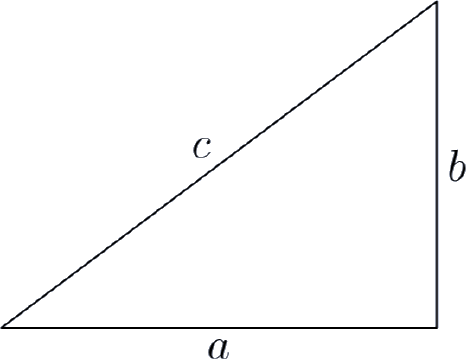
The relationship involving the legs and hypotenuse of the right triangle, given by
\[a^2 + b^2 = c^2 \label{1} \]
is called the Pythagorean Theorem .
Note that the Pythagorean Theorem can only be applied to right triangles. Let’s look at a simple application of the Pythagorean Theorem (Equat ion \ref{1}).
Example \(\PageIndex{2}\)
Given that the length of one leg of a right triangle is 4 centimeters and the hypotenuse has length 8 centimeters, find the length of the second leg.
Let’s begin by sketching and labeling a right triangle with the given information. We will let x represent the length of the missing leg.
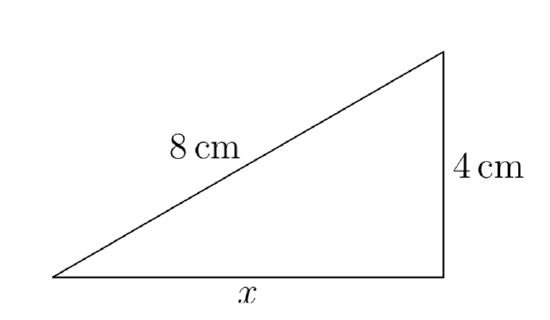
Here is an important piece of advice.
TIP \(\PageIndex{3}\): Hypotenuse
The hypotenuse is the longest side of the right triangle. It is located directly opposite the right angle of the triangle. Most importantly, it is the quantity that is isolated by itself in the Pythagorean Theorem (Equation \ref{1}). Always isolate the quantity representing the hypotenuse on one side of the equation. The "legs" go on the other side of the equation.
So, taking the tip to heart, and noting the lengths of the legs and hypotenuse in Figure 1 , we write
\(4^2+x^2 = 8^2\).
Square, then isolate x on one side of the equation.
\(16+x^2 = 64\)
\(x^2 = 48\)
Normally, we would take plus or minus the square root in solving this equation, but x represents the length of a leg, which must be a positive number. Hence, we take just the positive square root of 48.
\(x = \sqrt{48}\)
Of course, place your answer in simple radical form.
\(x = \sqrt{16}\sqrt{3}\)
\(x = 4\sqrt{3}\)
If need be, you can use your graphing calculator to approximate this length. To the nearest hundredth of a centimeter, \(x \approx 6.93\) centimeters.
Proof of the Pythagorean Theorem
It is not known whether Pythagoras was the first to provide a proof of the Pythagorean Theorem. Many mathematical historians think not. Indeed, it is not even known if Pythagoras crafted a proof of the theorem that bears his name, let alone was the first to provide a proof.
There is evidence that the ancient Babylonians were aware of the Pythagorean Theorem over a 1000 years before the time of Pythagoras. A clay tablet, now referred to as Plimpton 322 (see Figure 2 ), contains examples of Pythagorean Triples, sets of three numbers that satisfy the Pythagorean Theorem (such as 3, 4, 5).
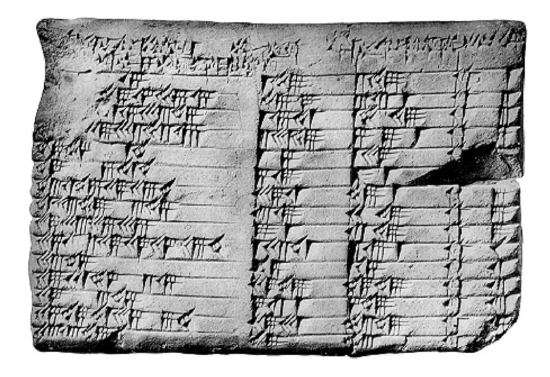
One of the earliest recorded proofs of the Pythagorean Theorem dates from the Han dynasty (206 BC to AD 220), and is recorded in the Chou Pei Suan Ching (see Figure 3 ). You can see that this figure specifically addresses the case of the 3, 4, 5 right triangle. Mathematical historians are divided as to whether or not the image was meant to be part of a general proof or was just devised to address this specific case. There is also disagreement over whether the proof was provided by a more modern commentator or dates back further in time.
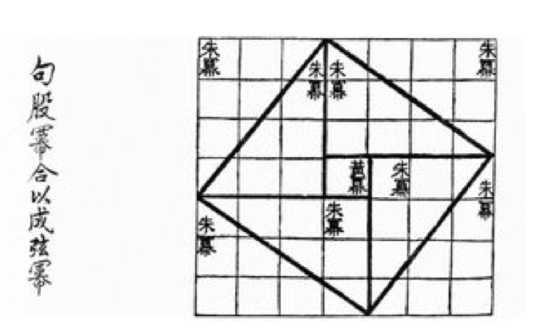
However, Figure 3 does suggest a path we might take on the road to a proof of the Pythagorean Theorem. Start with an arbitrary right triangle having legs of lengths a and b, and hypotenuse having length c, as shown in Figure 4 (a).
Next, make four copies of the triangle shown in Figure 4 (a), then rotate and translate them into place as shown in Figure 4 (b). Note that this forms a big square that is c units on a side.
Further, the position of the triangles in Figure 4 (b) allows for the formation of a smaller, unshaded square in the middle of the larger square. It is not hard to calculate the length of the side of this smaller square. Simply subtract the length of the smaller leg from the larger leg of the original triangle. Thus, the side of the smaller square has length b − a.
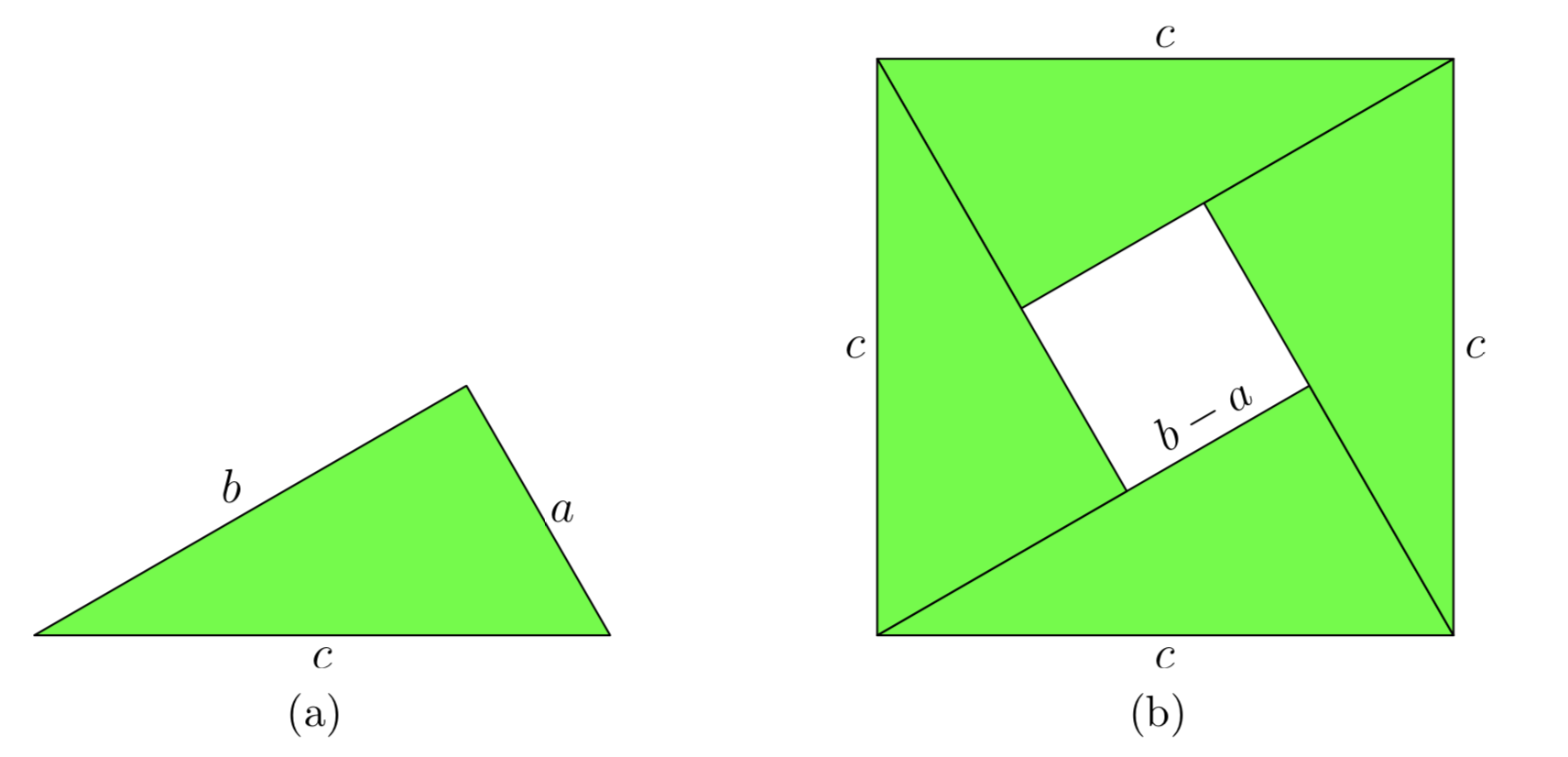
Now, we will calculate the area of the large square in Figure 4 (b) in two separate ways.
\(Area = c^2\).
- Secondly, the large square in Figure 4 (b) is made up of 4 triangles of the same size and one smaller square having a side of length b−a. We can calculate the area of the large square by summing the area of the 4 triangles and the smaller square.
- The area of the smaller square is \((b−a)^2\).
- The area of each triangle is \(\frac{ab}{2}\). Hence, the area of four triangles of equal size is four times this number;
i.e., \(4(\frac{ab}{2})\). Thus, the area of the large square is
Area = Area of small square + \(4 \cdot\) Area of triangle
=\((b−a)^2+4(\frac{ab}{2})\).
We calculated the area of the larger square twice. The first time we got \(c^2\); the second time we got \((b−a)^2+4(\frac{ab}{2})\). Therefore, these two quantities must be equal.
\(c^2 = (b−a)^2+4(\frac{ab}{2})\).
Expand the binomial and simplify.
\(c^2 = b^2−2ab+a^2 +2ab\)
\(c^2 = b^2+a^2\)
\(a^2+b^2 = c^2\),
and the Pythagorean Theorem is proven.
Applications of the Pythagorean Theorem
In this section we will look at a few applications of the Pythagorean Theorem, one of the most applied theorems in all of mathematics. Just ask your local carpenter.
The ancient Egyptians would take a rope with 12 equally spaced knots like that shown in Figure 5 , and use it to square corners of their buildings. The tool was instrumental in the construction of the pyramids.
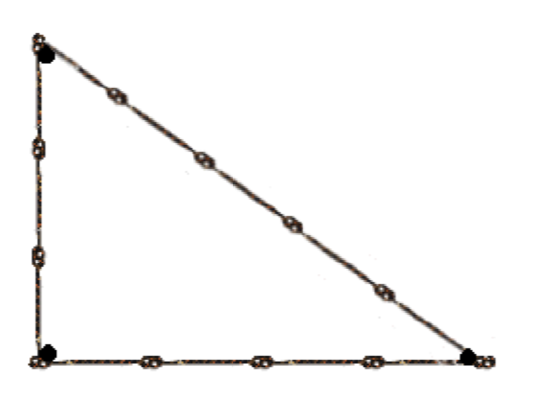
The Pythagorean theorem is also useful in surveying, cartography, and navigation, to name a few possibilities.
Let’s look at a few examples of the Pythagorean Theorem in action.
Example \(\PageIndex{4}\)
One leg of a right triangle is 7 meters longer than the other leg. The length of the hypotenuse is 13 meters. Find the lengths of all sides of the right triangle.
Let x represent the length of one leg of the right triangle. Because the second leg is 7 meters longer than the first leg, the length of the second leg can be represented by the expression x + 7, as shown in Figure 6 , where we’ve also labeled the length of the hypotenuse (13 meters).

Remember to isolate the length of the hypotenuse on one side of the equation representing the Pythagorean Theorem. That is,
\(x^2+(x+7)^2 = 13^2\).
Note that the legs go on one side of the equation, the hypotenuse on the other. Square and simplify. Remember to use the squaring a binomial pattern.
\(x^2+x^2+14x+49 = 169\)
\(2x^2 +14x+49 = 169\)
This equation is nonlinear, so make one side zero by subtracting 169 from both sides of the equation.
\(2x^2+14x+49−169 = 0\)
\(2x^2 +14x−120 = 0\)
Note that each term on the left-hand side of the equation is divisible by 2. Divide both sides of the equation by 2.
\(x^2+7x−60 = 0\)
Let’s use the quadratic formula with a = 1, b = 7, and c = −60.
\(x = \frac{−b \pm \sqrt{b^2−4ac}}{2a} = \frac{−7 \pm \sqrt{7^2 −4(1)(−60)}}{2(1)}\)
\(x = \frac{−7 \pm \sqrt{289}}{2}\)
Note that 289 is a perfect square (\(17^2 = 289\)). Thus,
\(x = \frac{−7 \pm 17}{2}\).
Thus, we have two solutions,
x = 5 or x = −12.
Because length must be a positive number, we eliminate − 12 from consideration. Thus, the length of the first leg is x = 5 meters. The length of the second leg is x +7, or 12 meters.
Check. Checking is an easy matter. The legs are 5 and 12 meters, respectively, and the hypotenuse is 13 meters. Note that the second leg is 7 meters longer than the first. Also,
\(5^2+12^2 = 25+144 = 169\) ,
which is the square of 13.
The integral sides of the triangle in the previous example, 5, 12, and 13, are an example of a Pythagorean Triple.
PYTHAGOREAN TRIPLE
A set of positive integers a, b, and c, is called a Pythagorean Triple if they satisfy the Pythagorean Theorem; that is, if
\(a^2+b^2 = c^2\).
If the greatest common factor of a, b, and c is 1, then the triple (a, b, c) is called a primitive Pythagorean Triple.
Thus, for example, the Pythagorean Triple (5 , 12 , 13) is primitive. Let’s look at another example.
Example \(\PageIndex{5}\)
If (a,b,c) is a Pythagorean Triple, show that any positive integral multiple is also a Pythagorean Triple.
Thus, if the positive integers (a, b, c) is a Pythagorean Triple, we must show that(ka, kb, kc ), where k is a positive integer, is also a Pythagorean Triple.
However, we know that
Multiply both sides of this equation by \(k^2\).
\(k^{2}a^2+k^{2}b^2 = k^{2}c^2\)
This last result can be written
\((ka)^2 + (kb)^2 = (kc)^2\).
Hence, (ka, kb, kc) is a Pythagorean Triple.
Hence, because (3 , 4 , 5) is a Pythagorean Triple, you can double everything to get another triple (6 , 8 , 10). Note that \(6^2 + 8^2 = 10^2\) is easily checked. Similarly, tripling gives another triple (9 , 12 , 15), and so on.
In Example 5 , we showed that (5 , 12 , 13) was a triple, so we can take multiples to generate other Pythagorean Triples, such as (10 , 24 , 26) or (15 , 36 , 39), and so on.
Formulae for generating Pythagorean Triples have been know since antiquity.
Example \(\PageIndex{6}\)
The following formula for generating Pythagorean Triples was published in Euclid’s (325–265 BC) Elements, one of the most successful textbooks in the history of mathematics. If m and n are positive integers with m > n, show
\(a = m^2−n^2\),
b = 2mn, (7)
\(c = m^2+n^2\),
generates Pythagorean Triples.
We need only show that the formulae for a , b , and c satisfy the Pythagorean Theo rem . With that is mind, let’s first compute \( a^ 2+ b^ 2\).
\(a^2+b^2 = (m^2−n^2)^2+(2mn)^2\)
= \(m^4−2m^{2}n^{2}+n^4+4m^{2}n^2\)
= \(m^4+2m^{2}n^2+n^4\)
On the other hand,
\(c^2 = (m^2+n^2)^2\)
= \(m^4+2m^{2}n^2+n^4\). Hence, \(a^2+b^2 = c^2\), and the expressions for a, b, and c form a Pythagorean Triple.
It is both interesting and fun to generate Pythagorean Triples with the formulae from Example 6 . Choose m = 4 and n = 2, then
\(a = m^2−n^2 = (4)^2−(2)^2 = 12\),
\(b = 2mn = 2(4)(2) = 16\),
\(c = m^2+n^2 =(4)^2+(2)^2 = 20\).
It is easy to check that the triple (12 , 16 , 20) will satisfy \(12^2+16^2 = 20^2\). Indeed, note that this triple is a multiple of the basic (3 , 4 , 5) triple, so it must also be a Pythagorean Triple.
It can also be shown that if m and n are relatively prime, and are not both odd or both even, then the formulae in Example 6 will generate a primitive Pythagorean Triple. For example, choose m = 5 and n = 2. Note that the greatest common divisor of m = 5 and n = 2 is one, so m and n are relatively prime. Moreover, m is odd while n is even. These values of m and n generate
\(a = m^2−n^2 = (5)^2−(2)^2 = 21\),
\(b = 2mn = 2(5)(2) = 20\),
\(c = m^2+n^2 = (5)^2+(2)^2 = 29\).
\(21^2+20^2 = 441+400 = 841 = 29^2\).
Hence, (21 , 20 , 29) is a Pythagorean Triple. Moreover, the greatest common divisor of 21, 20, and 29 is one, so (21 , 20 , 29) is primitive. The practical applications of the Pythagorean Theorem are numerous.
Example \(\PageIndex{8}\)
A painter leans a 20 foot ladder against the wall of a house. The base of the ladder is on level ground 5 feet from the wall of the house. How high up the wall of the house will the ladder reach?
Consider the triangle in Figure 7 . The hypotenuse of the triangle represents the ladder and has length 20 feet. The base of the triangle represents the distance of the base of the ladder from the wall of the house and is 5 feet in length. The vertical leg of the triangle is the distance the ladder reaches up the wall and the quantity we wish to determine.
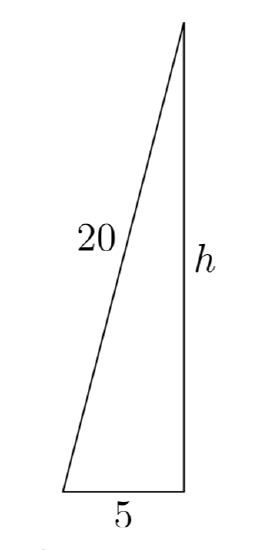
Applying the Pythagorean Theorem,
\(5^2+h^2 = 20^2\).
Again, note that the square of the length of the hypotenuse is the quantity that is isolated on one side of the equation.
Next, square, then isolate the term containing h on one side of the equation by subtracting 25 from both sides of the resulting equation.
\(25+h^2 = 400\)
\(h^2 = 375\)
We need only extract the positive square root.
\(h = \sqrt{375}\)
We could place the solution in simple form, that is, \(h = 5\sqrt{15}\), but the nature of the problem warrants a decimal approximation. Using a calculator and rounding to the nearest tenth of a foot,
\(h \approx 19.4\).
Thus, the ladder reaches about 19.4 feet up the wall.
The Distance Formula
We often need to calculate the distance between two points P and Q in the plane. Indeed, this is such a frequently recurring need, we’d like to develop a formula that will quickly calculate the distance between the given points P and Q. Such a formula is the goal of this last section.
Let P(x1, y1) and Q(x2, y2) be two arbitrary points in the plane, as shown in Figure 8 (a) and let d represent the distance between the two points.
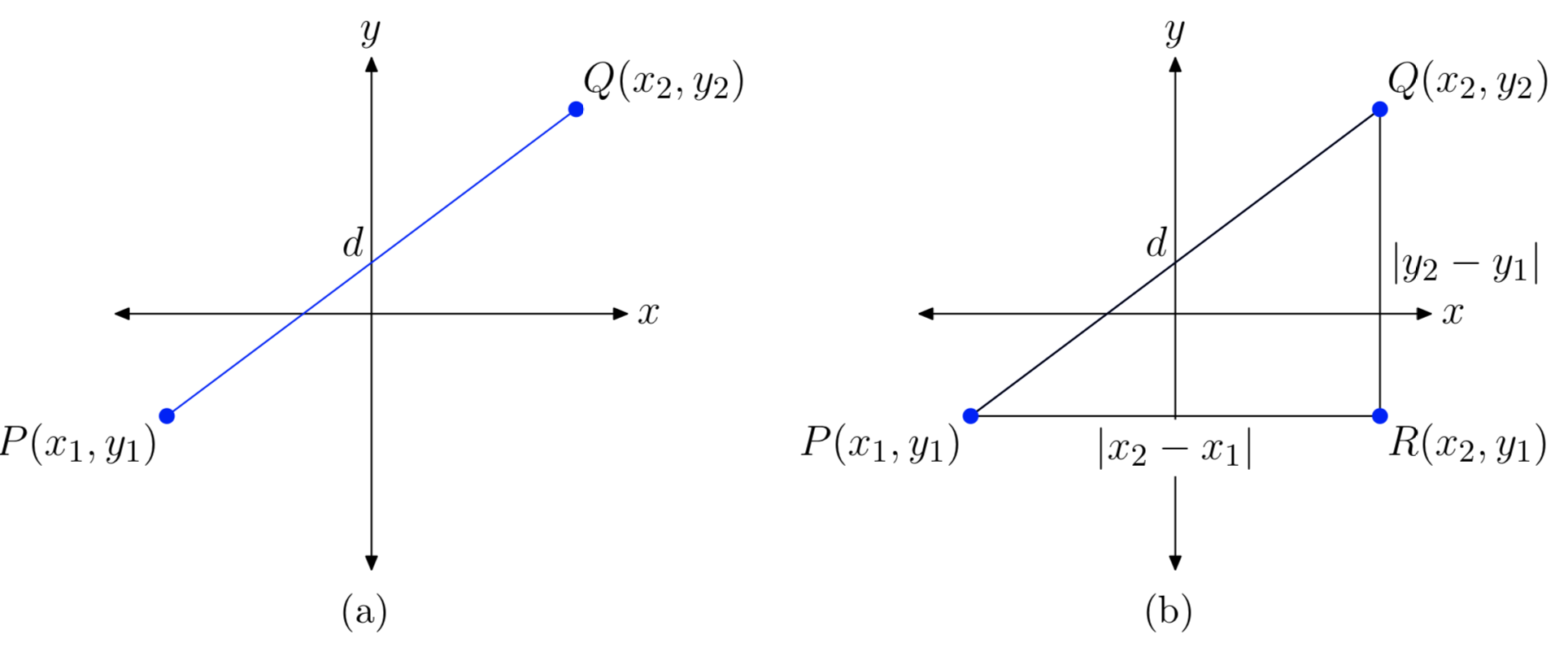
To find the distance d, first draw the right triangle △PQR, with legs parallel to the axes, as shown in Figure 8 (b). Next, we need to find the lengths of the legs of the right triangle △PQR.
- The distance between P and R is found by subtracting the x coordinate of P from the x-coordinate of R and taking the absolute value of the result. That is, the distance between P and R is \(|x_{2}−x_{1}|\).
- The distance between R and Q is found by subtracting the y-coordinate of R from the y-coordinate of Q and taking the absolute value of the result. That is, the distance between R and Q is \(|y_{2}−y_{1}|\).
We can now use the Pythagorean Theorem to calculate d. Thus,
\(d^2 = (|x_{2}−x_{1}|)^2+(|y_{2}−y_{1}|)^2\).
However, for any real number a,
\((|a|)^2 = |a|·|a| = |a^2| = a^2\),
because a2 is nonnegative. Hence, \((|x_{2} − x_{1}|)^2 = (x_{2} − x_{1})^2 and (|y_{2} − y_{1}|)^2 = (y_{2} − y_{1})^2\) and we can write
\(d^2 = (x_{2}−x_{1})^2+(y_{2}−y_{1})^2\).
Taking the positive square root leads to the Distance Formula.
THE DISTANCE FORMULA
Let P (x1, y1) and Q(x2, y2) be two arbitrary points in the plane. The distance d between the points P and Q is given by the formula
\(d = \sqrt{(x_{2}−x_{1})^2+(y_{2}−y_{1})^2}\). (9)
The direction of subtraction is unimportant. Because you square the result of the subtraction, you get the same response regardless of the direction of subtraction (e.g.\((5 − 2)^2 = (2 − 5)^2\)). Thus, it doesn’t matter which point you designate as the point P , nor does it matter which point you designate as the point Q . Simply subtract x - coordinates and square, subtract y -coordinates and square, add, then take the square root.
Let’s look at an example.
Example \(\PageIndex{10}\)
Find the distance between the points P (−4, −2) and Q (4, 4).
It helps the intuition if we draw a picture, as we have in Figure 9 . One can now take a compass and open it to the distance between points P and Q . Then you can place your compass on the horizontal axis (or any horizontal gridline ) to estimate the distance between the points P and Q . We did that on our graph paper and estimate the distance \(d \approx 10\).
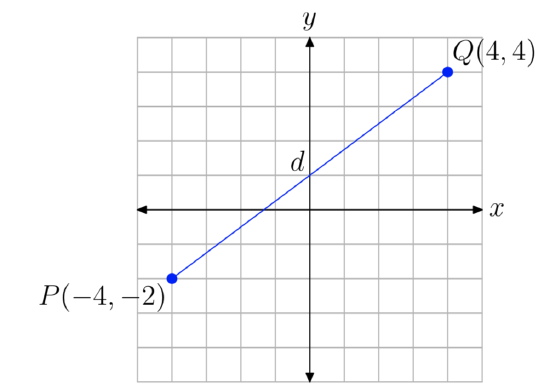
Let’s now use the distance formula to obtain an exact value for the distance d. With \((x_{1}, y_{1})\) = P (−4, −2) and \((x_{2}, y_{2})\) = Q (4, 4),
\(d = \sqrt{(x_{2}−x_{1})^2+(y_{2}−y_{1})^2}\)
= \(\sqrt{(4−(−4))^2+(4−(−2))^2}\)
= \(\sqrt{8^2+6^2}\)
= \(\sqrt{64+36}\)
= \(\sqrt{100}\)
It’s not often that your exact result agrees with your approximation, so never worry if you’re off by just a little bit.
In Exercises 1 - 8 , state whether or not the given triple is a Pythagorean Triple. Give a reason for your answer.
Exercise \(\PageIndex{1}\)
(8 , 15 , 17)
Yes, because \(8^2 + 15^2 = 17^2\)
Exercise \(\PageIndex{2}\)
(7 , 24 , 25)
Exercise \(\PageIndex{3}\)
No, because \(8^2+9^2 \ne 17^2\)
Exercise \(\PageIndex{4}\)
(4 , 9 , 13)
Exercise \(\PageIndex{5}\)
(12, 35, 37)
Yes, because \(12^2 + 35^2 = 37^2\)
Exercise \(\PageIndex{6}\)
(12 , 17 , 29)
Exercise \(\PageIndex{7}\)
(11 , 17 , 28)
No, because \(11^2 + 17^2 \ne 28^2\)
Exercise \(\PageIndex{8}\)
(11 , 60 , 61)
In Exercises 9 - 16 , set up an equation to model the problem constraints and solve. Use your answer to find the missing side of the given right triangle. Include a sketch with your solution and check your result.
Exercise \(\PageIndex{9}\)
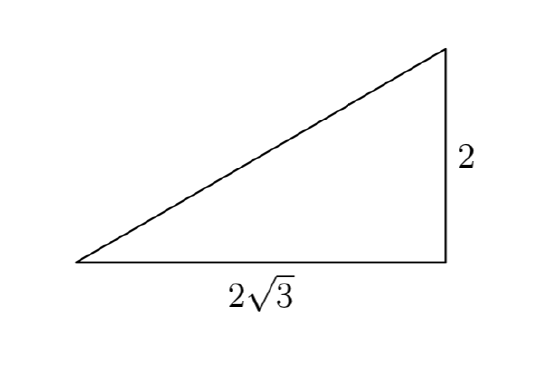
Exercise \(\PageIndex{10}\)
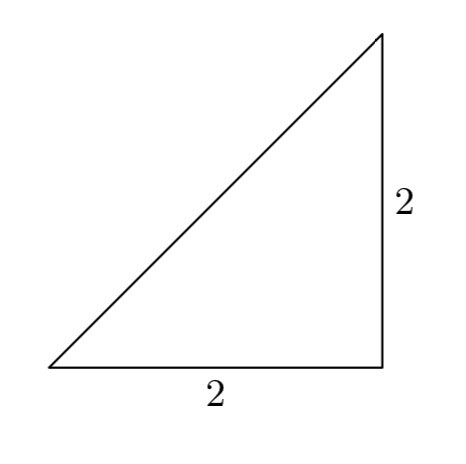
Exercise \(\PageIndex{11}\)
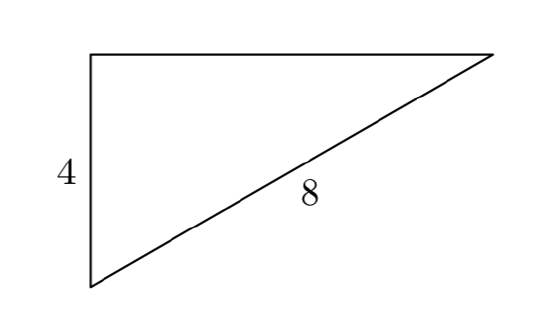
\(4\sqrt{2}\)
Exercise \(\PageIndex{12}\)

Exercise \(\PageIndex{13}\)

\(2\sqrt{2}\)
Exercise \(\PageIndex{14}\)
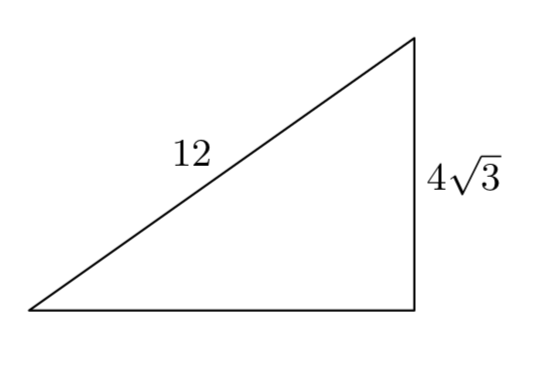
Exercise \(\PageIndex{15}\)
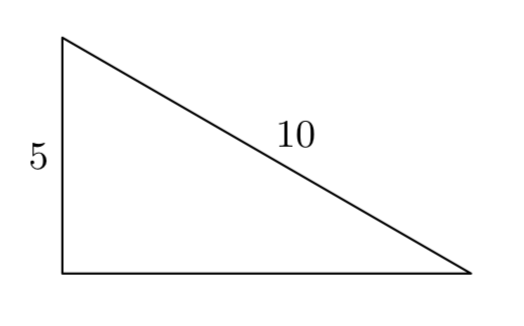
\(5\sqrt{3}\)
Exercise \(\PageIndex{16}\)
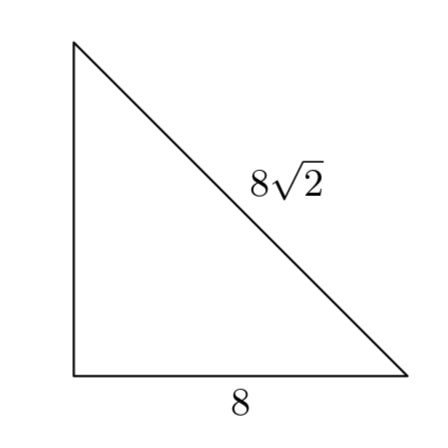
In Exercises 17 - 20 , set up an equation that models the problem constraints. Solve the equation and use the result to answer the question. Look back and check your result.
Exercise \(\PageIndex{17}\)
The legs of a right triangle are consecutive positive integers. The hypotenuse has length 5. What are the lengths of the legs?
The legs have lengths 3 and 4.
Exercise \(\PageIndex{18}\)
The legs of a right triangle are consecutive even integers. The hypotenuse has length 10. What are the lengths of the legs?
Exercise \(\PageIndex{19}\)
One leg of a right triangle is 1 centimeter less than twice the length of the first leg. If the length of the hypotenuse is 17 centimeters, find the lengths of the legs.
The legs have lengths 8 and 15 centimeters.
Exercise \(\PageIndex{20}\)
One leg of a right triangle is 3 feet longer than 3 times the length of the first leg. The length of the hypotenuse is 25 feet. Find the lengths of the legs.
Exercise \(\PageIndex{21}\)
Pythagoras is credited with the following formulae that can be used to generate Pythagorean Triples.
\(b = \frac{m^2−1}{2}\),
\(c = \frac{m^2+1}{2}\)
Use the technique of Example 6 to demonstrate that the formulae given above will generate Pythagorean Triples, provided that m is an odd positive integer larger than one. Secondly, generate at least 3 instances of Pythagorean Triples with Pythagoras’s formula.
(3, 4, 5), (5, 12, 13), and (7, 24, 25), with m = 3, 5, and 7, respectively.
Exercise \(\PageIndex{22}\)
Plato (380 BC) is credited with the following formulae that can be used to generate Pythagorean Triples.
\(b = m^2 − 1\),
\(c = m^2 + 1\)
Use the technique of Example 6 to demonstrate that the formulae given above will generate Pythagorean Triples, provided that m is a positive integer larger than 1. Secondly, generate at least 3 instances of Pythagorean Triples with Plato’s formula.
In Exercises 23 - 28 , set up an equation that models the problem constraints. Solve the equation and use the result to answer. Look back and check your answer.
Exercise \(\PageIndex{23}\)
Fritz and Greta are planting a 12-foot by 18-foot rectangular garden, and are laying it out using string. They would like to know the length of a diagonal to make sure that right angles are formed. Find the length of a diagonal. Approximate your answer to within 0.1 feet.
Exercise \(\PageIndex{24}\)
Angelina and Markos are planting a 20-foot by 28-foot rectangular garden, and are laying it out using string. They would like to know the length of a diagonal to make sure that right angles are formed. Find the length of a diagonal. Approximate your answer to within 0.1 feet.
Exercise \(\PageIndex{25}\)
The base of a 36-foot long guy wire is located 16 feet from the base of the telephone pole that it is anchoring. How high up the pole does the guy wire reach? Approximate your answer to within 0.1.
Exercise \(\PageIndex{26}\)
The base of a 35-foot long guy wire is located 10 feet from the base of the telephone pole that it is anchoring. How high up the pole does the guy wire reach? Approximate your answer to within 0.1 feet.
Exercise \(\PageIndex{27}\)
A stereo receiver is in a corner of a 13-foot by 16-foot rectangular room. Speaker wire will run under a rug, diagonally, to a speaker in the far corner. If 3 feet of slack is required on each end, how long a piece of wire should be purchased? Approximate your answer to within 0.1 feet.
Exercise \(\PageIndex{28}\)
A stereo receiver is in a corner of a 10-foot by 15-foot rectangular room. Speaker wire will run under a rug, diagonally, to a speaker in the far corner. If 4 feet of slack is required on each end, how long a piece of wire should be purchased? Approximate your answer to within 0.1 feet.
In Exercises 29 - 38 , use the distance formula to find the exact distance between the given points.
Exercise \(\PageIndex{29}\)
(−8, −9) and (6, −6)
\(\sqrt{205}\)
Exercise \(\PageIndex{30}\)
(1, 0) and ( − 9, − 2)
Exercise \(\PageIndex{31}\)
( − 9 , 1) and ( − 8 , 7)
\(\sqrt{37}\)
Exercise \(\PageIndex{32}\)
(0, 9) and (3, 1)
Exercise \(\PageIndex{33}\)
(6, −5) and (−9, −2)
\(\sqrt{234} = 3\sqrt{26}\)
Exercise \(\PageIndex{34}\)
(−5, 6) and (1, 4)
Exercise \(\PageIndex{35}\)
(−7, 7) and (−3, 6)
\(\sqrt{17}\)
Exercise \(\PageIndex{36}\)
(−7, −6) and (−2, −4)
Exercise \(\PageIndex{37}\)
(4, −3) and (−9, 6)
\(\sqrt{250} = 5\sqrt{10}\)
Exercise \(\PageIndex{38}\)
(−7, −1) and (4, −5)
In Exercises 39 - 42 , set up an equation that models the problem constraints. Solve the equation and use the result to answer the question. Look back and check your result.

Exercise \(\PageIndex{39}\)
Find k so that the point (4, k) is \(2\sqrt{2}\) units away from the point (2, 1).
k = 3, −1.
Exercise \(\PageIndex{40}\)
Find k so hat the point (k, 1) is \(2\sqrt{2}\) units away from the point (0, −1)
Exercise \(\PageIndex{41}\)
Find k so hat the point (k, 1) is \(\sqrt{17}\) units away from the point (2, −3)
Exercise \(\PageIndex{42}\)
Find k so that the point (−1, k) is \(\sqrt{13}\) units away from the point (−4, −3).
Exercise \(\PageIndex{43}\)
Set up a coordinate system on a sheet of graph paper. Label and scale each axis. Plot the points P (0, 5) and Q (4, −3) on your coordinate system.
a) Plot several points that are equidistant from the points P and Q on your coordinate system. What graph do you get if you plot all points that are equidistant from the points P and Q? Determine the equation of the graph by examining the resulting image on your coordinate system.
b) Use the distance formula to find the equation of the graph of all points that are equidistant from the points P and Q. Hint: Let (x, y) represent an arbitrary point on the graph of all points equidistant from points P and Q. Calculate the distances from the point (x, y) to the points P and Q separately, then set them equal and simplify the resulting equation. Note that this analytical approach should provide an equation that matches that found by the graphical approach in part (a).
a) In the figure that follows, XP = XQ.
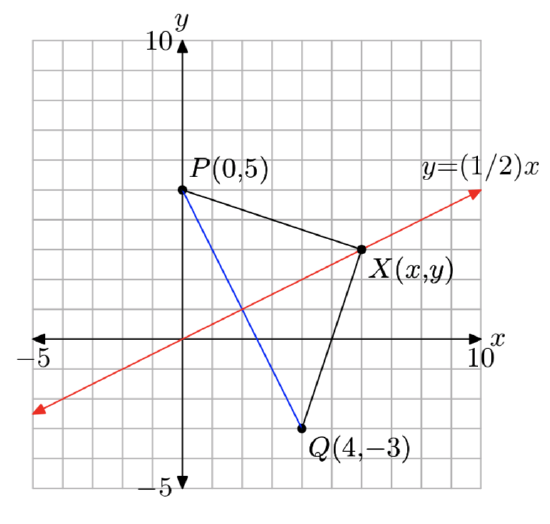
b) \(y = \frac{1}{2}x\)
Exercise \(\PageIndex{44}\)
Set up a coordinate system on a sheet of graph paper. Label and scale each axis. Plot the point P (0, 2) and label it with its coordinates. Draw the line y = −2 and label it with its equation.
a) Plot several points that are equidistant from the point P and the line y = −2 on your coordinate system. What graph do you get if you plot all points that are equidistant from the points P and the line y = −2.
b) Use the distance formula to find the equation of the graph of all points that are equidistant from the points P and the line y = −2. Hint: Let(x, y) represent an arbitrary point on the graph of all points equidistant from points P and the line y = −2. Calculate the distances from the point(x,y) to the points P and the line y = −2 separately, then set them equal and simplify the resulting equation.
Exercise \(\PageIndex{45}\)
Copy the following figure onto a sheet of graph paper. Cut the pieces of the first figure out with a pair of scissors, then rearrange them to form the second figure. Explain how this proves the Pythagorean Theorem.
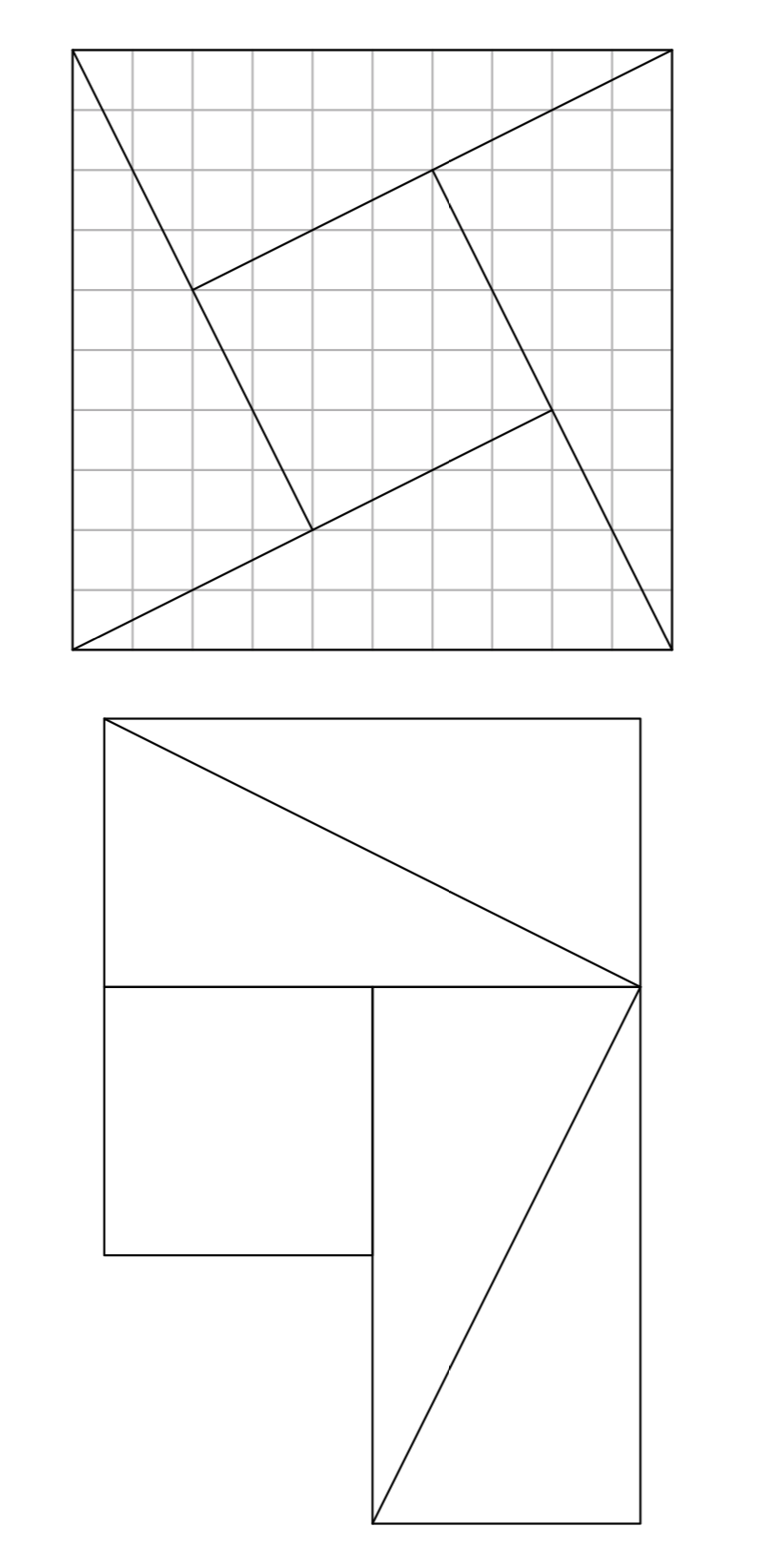
Exercise \(\PageIndex{46}\)
Compare this image to the one that follows and explain how this proves the Pythagorean Theorem.
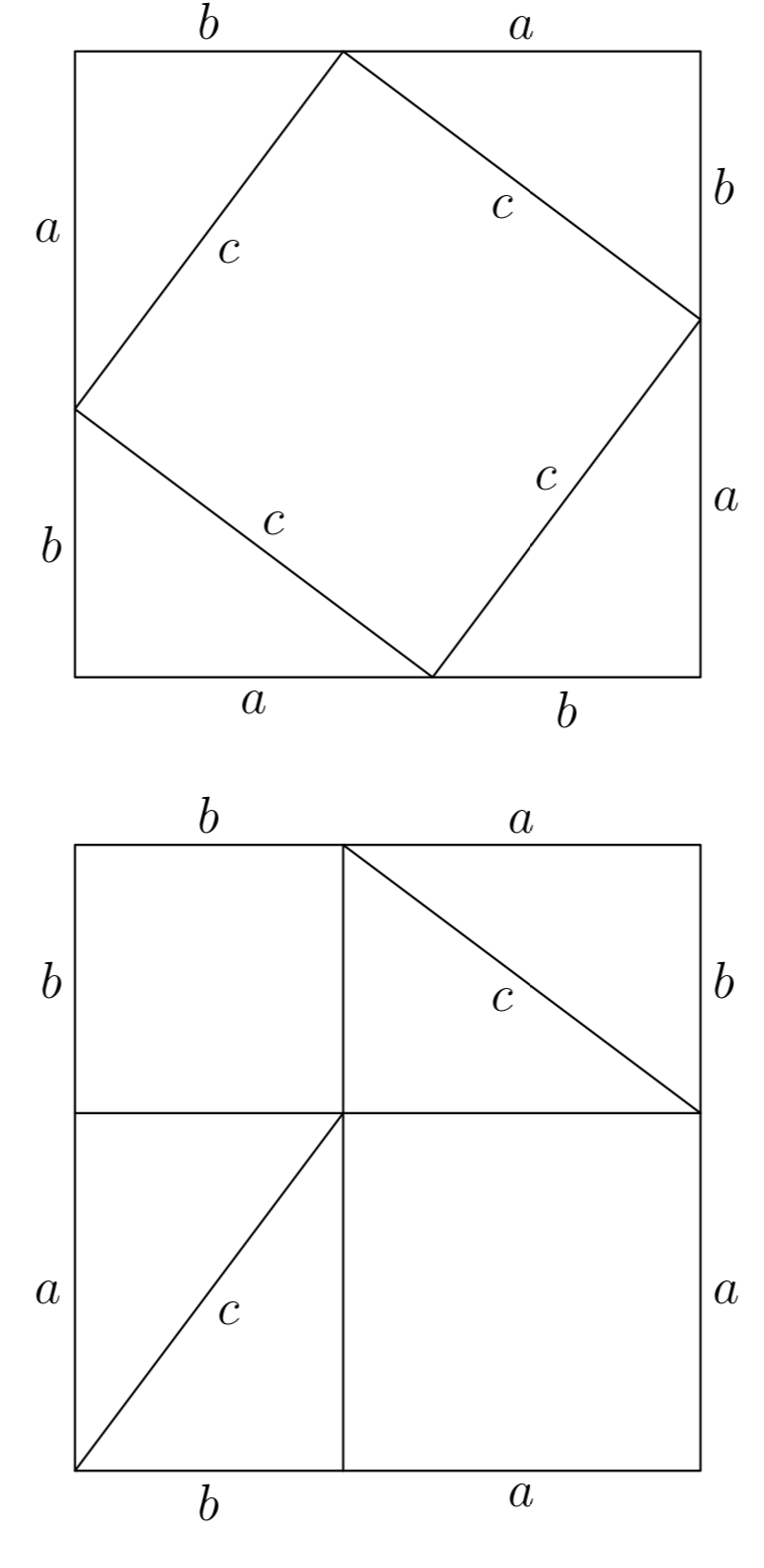

- Science Notes Posts
- Contact Science Notes
- Todd Helmenstine Biography
- Anne Helmenstine Biography
- Free Printable Periodic Tables (PDF and PNG)
- Periodic Table Wallpapers
- Interactive Periodic Table
- Periodic Table Posters
- How to Grow Crystals
- Chemistry Projects
- Fire and Flames Projects
- Holiday Science
- Chemistry Problems With Answers
- Physics Problems
- Unit Conversion Example Problems
- Chemistry Worksheets
- Biology Worksheets
- Periodic Table Worksheets
- Physical Science Worksheets
- Science Lab Worksheets
- My Amazon Books
Pythagorean Theorem – Definition, Formula, Problems

In mathematic, the Pythagorean theorem states that the square of the hypotenuse of a right triangle is equal to the sum of the squares of its other two sides . Another way of stating the theorem is that the sum of the areas of the squares formed by the sides of a right triangle equals the area of the square whose side is the hypotenuse. The theorem is a key relation in Euclidean geometry. It is named for the Greek philosopher Pythagorus.
Remember: The Pythagorean theorem only applies to right triangles!
Pythagorean Theorem Formula
The formula for the Pythagorean theorem describes the relationship between the sides a and b of a right triangle to its hypotenuse, c . A right triangle is one containing a 90° or right angle. The hypotenuse is the side of the triangle opposite from the right angle (which is the largest angle in a right triangle).
a 2 + b 2 = c 2
Solving for a, b, and c
Rearranging the equation gives the formulas solving for a, b, and c:
- a = (c 2 – b 2 ) ½
- b = (c 2 – a 2 ) ½
- c = (a 2 + b 2 ) ½
How to Solve the Pythagorean Theorem – Example Problems
For example, find the hypotenuse of a right triangle with side that have lengths of 5 and 12.
Start with the formula for the Pythagorean theorem and plug in the numbers for the sides a and b to solve for c .
a 2 + b 2 = c 2 5 2 + 12 2 = c 2 c 2 = 5 2 + 12 2 = 25 + 144 = 169 c2 = 169 c = √169 or 169 ½ = 13
For example, solve for side b of a triangle where a is 9 and the hypotenuse c is 15.
a 2 + b 2 = c 2 9 2 + b 2 = 15 2 b 2 = 15 2 – 9 2 = 225 – 81 = 144 b = √144 = 12
Now, let’s combine a bit of algebra with the geometry. Solve for x where the sides of a right triangle are 5x and 4x +5 and the hypotenuse has a length of 8x -3.
a 2 + b 2 = c 2 (5x) 2 + (4x +5) 2 = (8x-3) 2
The (4x + 5) 2 and (8x -3)2 terms are the squares of binomial expressions. So, expanding the equation gives the following:
25x 2 + (4x +5)(4x +5) = (8x -3)(8x -3) 25x 2 = 16×2 + 20x +20x + 25 = 64x – 24x – 24x + 9
Combine like terms:
41x 2 + 40x + 25 = 64x 2 – 48x + 9
Rewrite the equation and solve for x.
0 = 23x 2 – 88x – 16
Apply the quadratic equation and solve for x:
x = [-b ± √(b 2 -4ac)]/2a x = [-(-88) ± √[-88 2 – 4(23)(-16)] / 2(23) = [88 ± √(7744 + 1472)] / 46 = (88 ± 96) / 46
So, there are two answers:
x = (88 + 96)/46 = 4 and (88 – 96).46 = -4/23
A triangle does not have a negative length for its side, so x is 4.
Plugging in”4″ in place of x, the sides of the right triangle are 20, 21, and 29.
Pythagorean Triples
Pythagorean triples are integers a, b, and c, that represent the sides of a right triangle and satisfy the Pythagorean theorem. Here is the list of Pythagorean triples for integers with values less than 100:
(3, 4, 5), (5, 12, 13), (7, 24, 25), (8, 15, 17), (9, 40, 41), (11, 60, 61), (12, 35, 37), (13, 84, 85), (16, 63, 65), (20, 21, 29), (28, 45, 53), (33, 56, 65), (36, 77, 85), (39, 80, 89), (48, 55, 73), (65, 72, 97)
Proof of the Pythagorean Theorem
There are more proofs for the Pythagorean theorem than for any other theorem in geometry! At least 370 proofs are known. Some of these proofs use the parallel postulate. Some rely on the complementarity of acute angles in a right triangle. Proofs using shearing use the properties of parallelograms.
History – Did Pythagoras Discover the Pythagorean Theorem?
While the Pythagorean theorem takes its name from Pythagorus, he did not discover it. Exactly who gets the credit or whether many different places made the discovery independently is a matter of debate. The Mesopotamians made calculations using the formula as early as 2000 BC, which was over a thousand years before Pythagorus. A papyrus from the Egyptian Middle Kingdom, dating between 2000 and 1786 BC, references a math problem describing Pythagorean triples. The Baudhayana Shulba Sutra from India (dating between the 8th and 5th century BC) lists both Pythagorean triples and the Pythagorean theorem. The “Gougu theorem” from China offers a proof for the Pythagorean theorem, which came into use long before its oldest surviving description from the 1st century BC.
Pythagorus of Samos lived between 570 and 495 BC. While he was not the original person who formulated the Pythagorean theorem, he (or his students) may have introduced its proof to ancient Greece. In any case, his philosophical treatment of math left a lasting impression on the world.
- Bell, John L. (1999). The Art of the Intelligible: An Elementary Survey of Mathematics in its Conceptual Development . Kluwer. ISBN 0-7923-5972-0.
- Heath, Sir Thomas (1921). “ The ‘Theorem of Pythagoras ‘”. A History of Greek Mathematics (2 Vols.) (Dover Publications, Inc. (1981) ed.). Oxford: Clarendon Press. ISBN 0-486-24073-8.
- Maor, Eli (2007). The Pythagorean Theorem: A 4,000-Year History . Princeton, New Jersey: Princeton University Press. ISBN 978-0-691-12526-8.
- Swetz, Frank; Kao, T. I. (1977). Was Pythagoras Chinese?: An Examination of Right Triangle Theory in Ancient China . Pennsylvania State University Press. ISBN 0-271-01238-2.
Related Posts
Module 11: Geometry
Using the pythagorean theorem to solve problems, learning outcomes.
- Use the pythagorean theorem to find the unknown length of a right triangle given the two other lengths
The Pythagorean Theorem is a special property of right triangles that has been used since ancient times. It is named after the Greek philosopher and mathematician Pythagoras who lived around [latex]500[/latex] BCE.
Remember that a right triangle has a [latex]90^\circ [/latex] angle, which we usually mark with a small square in the corner. The side of the triangle opposite the [latex]90^\circ [/latex] angle is called the hypotenuse, and the other two sides are called the legs. See the triangles below.
In a right triangle, the side opposite the [latex]90^\circ [/latex] angle is called the hypotenuse and each of the other sides is called a leg.

Study Guides > Prealgebra
Using the pythagorean theorem to solve problems, learning outcomes.
- Use the pythagorean theorem to find the unknown length of a right triangle given the two other lengths
The Pythagorean Theorem is a special property of right triangles that has been used since ancient times. It is named after the Greek philosopher and mathematician Pythagoras who lived around [latex]500[/latex] BCE. Remember that a right triangle has a [latex]90^\circ [/latex] angle, which we usually mark with a small square in the corner. The side of the triangle opposite the [latex]90^\circ [/latex] angle is called the hypotenuse, and the other two sides are called the legs. See the triangles below.

The Pythagorean Theorem
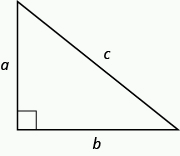
Licenses & Attributions
Cc licensed content, original.
- Question ID 146918, 146916, 146914, 146913. Authored by: Lumen Learning. License: CC BY: Attribution .
CC licensed content, Specific attribution
- Prealgebra. Provided by: OpenStax License: CC BY: Attribution . License terms: Download for free at http://cnx.org/contents/ [email protected] .
Please add a message.
Message received. Thanks for the feedback.
MathBootCamps
The pythagorean theorem with examples.
The Pythagorean theorem is a way of relating the leg lengths of a right triangle to the length of the hypotenuse, which is the side opposite the right angle. Even though it is written in these terms, it can be used to find any of the side as long as you know the lengths of the other two sides. In this lesson, we will look at several different types of examples of applying this theorem.
Table of Contents
- Examples of using the Pythagorean theorem
- Solving applied problems (word problems)
- Solving algebraic problems
[adsenseWide]
Applying the Pythagorean theorem (examples)
In the examples below, we will see how to apply this rule to find any side of a right triangle triangle. As in the formula below, we will let a and b be the lengths of the legs and c be the length of the hypotenuse. Remember though, that you could use any variables to represent these lengths.

In each example, pay close attention to the information given and what we are trying to find. This helps you determine the correct values to use in the different parts of the formula.
Find the value of \(x\).

The side opposite the right angle is the side labelled \(x\). This is the hypotenuse. When applying the Pythagorean theorem, this squared is equal to the sum of the other two sides squared. Mathematically, this means:
\(6^2 + 8^2 = x^2\)
Which is the same as:
\(100 = x^2\)
Therefore, we can write:
\(\begin{align}x &= \sqrt{100}\\ &= \bbox[border: 1px solid black; padding: 2px]{10}\end{align}\)
Maybe you remember that in an equation like this, \(x\) could also be –10, since –10 squared is also 100. But, the length of any side of a triangle can never be negative and therefore we only consider the positive square root.
In other situations, you will be trying to find the length of one of the legs of a right triangle. You can still use the Pythagorean theorem in these types of problems, but you will need to be careful about the order you use the values in the formula.
Find the value of \(y\).

The side opposite the right angle has a length of 12. Therefore, we will write:
\(8^2 + y^2 = 12^2\)
This is the same as:
\(64 + y^2 = 144\)
Subtracting 64 from both sides:
\(y^2 = 80\)
\(\begin{align}y &= \sqrt{80} \\ &= \sqrt{16 \times 5} \\ &= \bbox[border: 1px solid black; padding: 2px]{4\sqrt{5}}\end{align}\)
In this last example, we left the answer in exact form instead of finding a decimal approximation. This is common unless you are working on an applied problem.
Applications (word problems) with the Pythagorean theorem
There are many different kinds of real-life problems that can be solved using the Pythagorean theorem. The easiest way to see that you should be applying this theorem is by drawing a picture of whatever situation is described.
Two hikers leave a cabin at the same time, one heading due south and the other headed due west. After one hour, the hiker walking south has covered 2.8 miles and the hiker walking west has covered 3.1 miles. At that moment, what is the shortest distance between the two hikers?
First, sketch a picture of the information given. Label any unknown value with a variable name, like x.

Due south and due west form a right angle, and the shortest distance between any two points is a straight line. Therefore, we can apply the Pythagorean theorem and write:
\(3.1^2 + 2.8^2 = x^2\)
Here, you will need to use a calculator to simplify the left-hand side:
\(17.45 = x^2\)
Now use your calculator to take the square root. You will likely need to round your answer.
\(\begin{align}x &= \sqrt{17.45} \\ &\approx 4.18 \text{ miles}\end{align}\)
As you can see, it will be up to you to determine that a right angle is part of the situation given in the word problem. If it isn’t, then you can’t use the Pythagorean theorem.
Algebra style problems with the Pythagorean theorem
There is one last type of problem you might run into where you use the Pythagorean theorem to write some type of algebraic expression. This is something that you will not need to do in every course, but it does come up.
A right triangle has a hypotenuse of length \(2x\), a leg of length \(x\), and a leg of length y. Write an expression that shows the value of \(y\) in terms of \(x\).
Since no figure was given, your first step should be to draw one. The order of the legs isn’t important, but remember that the hypotenuse is opposite the right angle.

Now you can apply the Pythagorean theorem to write:
\(x^2 + y^2 = (2x)^2\)
Squaring the right-hand side:
\(x^2 + y^2 = 4x^2\)
When the problem says “the value of \(y\)”, it means you must solve for \(y\). Therefore, we will write:
\(y^2 = 4x^2 – x^2\)
Combining like terms:
\(y^2 = 3x^2\)
Now, use the square root to write:
\(y = \sqrt{3x^2}\)
Finally, this simplifies to give us the expression we are looking for:
\(y = \bbox[border: 1px solid black; padding: 2px]{x\sqrt{3x}}\)
[adsenseLargeRectangle]
The Pythagorean theorem allows you to find the length of any of the three sides of a right triangle. It is one of those things that you should memorize, as it comes up in all areas of math, and therefore in many different math courses you will probably take. Remember to avoid the common mistake of mixing up where the legs go in the formula vs. the hypotenuse and to always draw a picture when one isn’t given.
Share this:
- Click to share on Twitter (Opens in new window)
- Click to share on Facebook (Opens in new window)
- + ACCUPLACER Mathematics
- + ACT Mathematics
- + AFOQT Mathematics
- + ALEKS Tests
- + ASVAB Mathematics
- + ATI TEAS Math Tests
- + Common Core Math
- + DAT Math Tests
- + FSA Tests
- + FTCE Math
- + GED Mathematics
- + Georgia Milestones Assessment
- + GRE Quantitative Reasoning
- + HiSET Math Exam
- + HSPT Math
- + ISEE Mathematics
- + PARCC Tests
- + Praxis Math
- + PSAT Math Tests
- + PSSA Tests
- + SAT Math Tests
- + SBAC Tests
- + SIFT Math
- + SSAT Math Tests
- + STAAR Tests
- + TABE Tests
- + TASC Math
- + TSI Mathematics
- + ACT Math Worksheets
- + Accuplacer Math Worksheets
- + AFOQT Math Worksheets
- + ALEKS Math Worksheets
- + ASVAB Math Worksheets
- + ATI TEAS 6 Math Worksheets
- + FTCE General Math Worksheets
- + GED Math Worksheets
- + 3rd Grade Mathematics Worksheets
- + 4th Grade Mathematics Worksheets
- + 5th Grade Mathematics Worksheets
- + 6th Grade Math Worksheets
- + 7th Grade Mathematics Worksheets
- + 8th Grade Mathematics Worksheets
- + 9th Grade Math Worksheets
- + HiSET Math Worksheets
- + HSPT Math Worksheets
- + ISEE Middle-Level Math Worksheets
- + PERT Math Worksheets
- + Praxis Math Worksheets
- + PSAT Math Worksheets
- + SAT Math Worksheets
- + SIFT Math Worksheets
- + SSAT Middle Level Math Worksheets
- + 7th Grade STAAR Math Worksheets
- + 8th Grade STAAR Math Worksheets
- + THEA Math Worksheets
- + TABE Math Worksheets
- + TASC Math Worksheets
- + TSI Math Worksheets
- + AFOQT Math Course
- + ALEKS Math Course
- + ASVAB Math Course
- + ATI TEAS 6 Math Course
- + CHSPE Math Course
- + FTCE General Knowledge Course
- + GED Math Course
- + HiSET Math Course
- + HSPT Math Course
- + ISEE Upper Level Math Course
- + SHSAT Math Course
- + SSAT Upper-Level Math Course
- + PERT Math Course
- + Praxis Core Math Course
- + SIFT Math Course
- + 8th Grade STAAR Math Course
- + TABE Math Course
- + TASC Math Course
- + TSI Math Course
- + Number Properties Puzzles
- + Algebra Puzzles
- + Geometry Puzzles
- + Intelligent Math Puzzles
- + Ratio, Proportion & Percentages Puzzles
- + Other Math Puzzles
How to Solve Pythagorean Theorem Problems? (+FREE Worksheet!)
In mathematics, the Pythagorean Theorem is the relationship between three sides of a right triangle.

Related Topics
- How Calculate the Area of Trapezoids
- How to Find the volume and surface area of Rectangular Prisms
- How to Solve Triangles Problems
- How to Find Volume and Surface Area of Cubes
- How to Find the Perimeter of Polygons
Step by step guide to solve Pythagorean Theorem problems
- We can use the Pythagorean Theorem to find a missing side in a right triangle.
The Absolute Best Books to Ace Pre-Algebra to Algebra II
The Ultimate Algebra Bundle From Pre-Algebra to Algebra II
The pythagorean theorem – example 1:.
Right triangle ABC has two legs of lengths \(9\) cm (AB) and \(12\) cm (AC). What is the length of the third side (BC)?
Use Pythagorean Theorem: \(\color{blue}{a^2+b^2= c^2}\) Then: \(a^2+b^2= c^2 →9^2+12^2= c^2 →81+144=c^2\) \(c^2=225 →\) \(c=\sqrt{225}=15\) \(cm\) → \(c=15 cm\)
The Pythagorean Theorem – Example 2:
Use Pythagorean Theorem: \(\color{blue}{a^2+b^2= c^2}\) Then: \(a^2+b^2= c^2 →8^2+6^2= c^2 →64+36=c^2\) \(c^2=100 →\) \(c=\sqrt{100}=10\) → \(c=10\)
The Pythagorean Theorem – Example 3:
Find the hypotenuse of the following right triangle.
Use Pythagorean Theorem: \(\color{blue}{a^2+b^2= c^2}\) Then: \(a^2+b^2= c^2 →3^2+4^2= c^2 →9+16=c^2\) \(c^2=25 →\) \(c=\sqrt{25}=5\) → \(c=5\)
The Best Book to Help You Ace Pre-Algebra
Pre-Algebra for Beginners The Ultimate Step by Step Guide to Preparing for the Pre-Algebra Test
The pythagorean theorem – example 4:.
Right triangle ABC has two legs of lengths \(6\) cm (AB) and \(8\) cm (AC). What is the length of the third side (BC)?
Use Pythagorean Theorem: \(\color{blue}{a^2+b^2= c^2}\) Then: \(a^2+b^2= c^2 →6^2+8^2= c^2 →36+64=c^2\) \( c^2=100 →\) \(c=\sqrt{100}=10\) \(cm\) → \(c= 10 cm\)
Exercises for Solveing the Pythagorean Theorem
Find the missing side in each right triangle., download pythagorean relationship worksheet.
- \(\color{blue}{13}\)
- \(\color{blue}{5}\)
- \(\color{blue}{15}\)
- \(\color{blue}{8}\)
The Greatest Books for Students to Ace the Algebra
Pre-Algebra Exercise Book A Comprehensive Workbook + PreAlgebra Practice Tests
Pre-algebra in 10 days the most effective pre-algebra crash course, college algebra practice workbook the most comprehensive review of college algebra, high school algebra i a comprehensive review and step-by-step guide to mastering high school algebra 1, 10 full length clep college algebra practice tests the practice you need to ace the clep college algebra test.
by: Effortless Math Team about 4 years ago (category: Articles , Free Math Worksheets )
Effortless Math Team
Related to this article, more math articles.
- The Ultimate 6th Grade K-PREP Math Course (+FREE Worksheets)
- Where to Go to Get Math Homework Help Quickly and Effectively?
- Best Books for Students Preparing for the SAT Math Test
- What Kind of Math do You Need to Be a Medical Assistant?
- FREE HSPT Math Practice Test
- Riemann Sums Made Easy: Step-by-Step Tutorial
- Area and Perimeter
- SSAT Upper Level Math FREE Sample Practice Questions
- Number Properties Puzzle – Challenge 6
- How to Graph Trigonometric Functions?
What people say about "How to Solve Pythagorean Theorem Problems? (+FREE Worksheet!) - Effortless Math: We Help Students Learn to LOVE Mathematics"?
No one replied yet.
Leave a Reply Cancel reply
You must be logged in to post a comment.
Pre-Algebra Practice Workbook The Most Comprehensive Review of Pre-Algebra
Algebra i practice workbook the most comprehensive review of algebra 1, algebra ii practice workbook the most comprehensive review of algebra 2, algebra i for beginners the ultimate step by step guide to acing algebra i, algebra ii for beginners the ultimate step by step guide to acing algebra ii, pre-algebra tutor everything you need to help achieve an excellent score.
- ATI TEAS 6 Math
- ISEE Upper Level Math
- SSAT Upper-Level Math
- Praxis Core Math
- 8th Grade STAAR Math
Limited time only!
Save Over 45 %
It was $89.99 now it is $49.99
Login and use all of our services.
Effortless Math services are waiting for you. login faster!
Register Fast!
Password will be generated automatically and sent to your email.
After registration you can change your password if you want.
- Math Worksheets
- Math Courses
- Math Topics
- Math Puzzles
- Math eBooks
- GED Math Books
- HiSET Math Books
- ACT Math Books
- ISEE Math Books
- ACCUPLACER Books
- Premium Membership
- Youtube Videos
- Google Play
- Apple Store
Effortless Math provides unofficial test prep products for a variety of tests and exams. All trademarks are property of their respective trademark owners.
- Bulk Orders
- Refund Policy

- school Campus Bookshelves
- menu_book Bookshelves
- perm_media Learning Objects
- login Login
- how_to_reg Request Instructor Account
- hub Instructor Commons
- Download Page (PDF)
- Download Full Book (PDF)
- Periodic Table
- Physics Constants
- Scientific Calculator
- Reference & Cite
- Tools expand_more
- Readability
selected template will load here
This action is not available.

4.34: Solving Equations Using the Pythagorean Theorem
- Last updated
- Save as PDF
- Page ID 4969
Use a-squared + b-squared = c-squared to find missing side lengths of right triangles.

Gary wants to build a skateboard ramp, but it can’t be too steep. If he has a platform 3 m high and a board 5 m long, how far out should the board extend from the platform?
In this concept, you will learn how to solve equations using the Pythagorean Theorem .
The Pythagorean Theorem states that the sum of the squares of the two legs of a right triangle is equal to the square of the hypotenuse . In a math sentence, where a and b are the legs and c is the hypotenuse, it looks like this:
\(c^2=a^2+b^2\)
Mathematically, you can use this equation to solve for any of the variables, not just the hypotenuse.
For example, the right triangle below has one leg equal to 3 and a hypotenuse of 5.
Solve for the other leg.
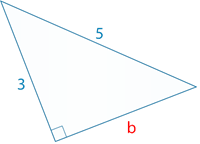
First, you can label either leg \(a\) or \(b\). Remember that the legs are those sides adjacent to the right angle.
Next, fill into the Pythagorean Theorem the values that you know.
\(\begin{align*} c^2 &= a^2+b^2 \\ 5^2 &= 3^2+b^2 \end{align*}\)
Then, perform the calculations you are able to.
\(25=9+b^2\)
Remember that your goal is to isolate the unknown variable on one side of the equation. In this case it is b and it is attached to a square and a+9. Perform the necessary operations to isolate b.
\(\begin{align*} 25−9 &= 9+b^2−9 \\ 16 &= b^2 \\ 4 &= b \end{align*}\)
The answer is 4.
Example \(\PageIndex{1}\)
Earlier, you were given a problem about Gary and his skate board ramp.
One side, the base, was 4 m and the board, the hypotenuse, was 5 m. How high would the ramp be?
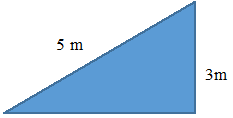
First, substitute.
\(5^2=3^2+b^2\)
Next, perform the calculations.
\(\begin{align*} 25 &= 9+b^2 \\ 25−9 &= 9+b^2−9 \end{align*}\)
Then, determine the square roots.
\(\begin{align*} 16 &= b^2 \\ 4 &= b \end{align*}\)
The answer is 4 m. Gary’s board should extend 4 m from the base of the platform.
Example \(\PageIndex{2}\)
Solve for b to the nearest tenth.

First, take the given lengths and substitute them into the formula.
\(\begin{align*} 4^2+b^2 &= 122 \\ 16+b^2 &= 144 \end{align*}\)
Next, subtract 16 from both sides of the equation.
\(\begin{align*} 16−16+b^2 &= 144−16 \\ b^2 &= 128 \end{align*}\)
Then take the square root of both sides of the equation.
\(b = 11.3137085 \ldots \)
Round to the tenths place
\(b\neq 11.3\)
The answer is 11.3
Example \(\PageIndex{3}\)
A right triangle includes the dimensions of \(a\), \(b=6\) and \(c=13\). Solve for a\).
\(\begin{align*} c^2 &= a^2+b^2 \\ 13^2 &= a^2+6^2 \end{align*}\)
Next, perform the calculations you are able to.
\(\begin{align*} 169 &= a^2+36 \\ 169−36 &= a^2+36−36 \\ 133 &= a^2 \\ 11.532582594 \ldots &= a \\ 11.5 &\approx a \end{align*}\)
The answer is \(a=11.5\).
Example \(\PageIndex{4}\)
A right triangle with \(a=8\),\(b\), and \(c=12\)
\(\begin{align*} c^2 &= a^2+b^2 \\ 12^2 &= 8^2+b^2 \end{align*}\)
\(\begin{align*} 144 &= 64+b^2 \\ 144−64 &= 64+b^2−64 \end{align*}\)
\(\begin{align*} 80 &= b^2 \\ 8.9 &\neq b \end{align*}\)
The answer is 8.9
Example \(\PageIndex{5}\)
A right triangle with \(a=6\), \(b\), and \(c=10\)
\(\begin{align*} c^2 &= a^2+b^2 \\ 10^2 &= 6^2+b^2 \end{align*}\)
\(\begin{align*} 100 &= 36+b^2 \\ 100−36 &= 36+b^2−36 \end{align*}\)
\(\begin{align*} 64 &= b^2 \\ 8 &= b \end{align*} \)
The answer is 8.
Use the Pythagorean Theorem to find the length of each missing leg. You may round to the nearest tenth when necessary.
- \(a=6, \:b=?, \:c=12 \)
- \(a=9, \:b=?, \:c=15 \)
- \(a=4, \:b=?, \:c=5 \)
- \(a=9, \:b=?, \:c=18 \)
- \(a=15, \:b=?, \:c=25 \)
- \(a=?, \:b=10, \:c=12 \)
- \(a=?, \:b=11,\: c=14 \)
- \(a=?,\: b=13,\: c=15 \)
Write an equation using the Pythagorean Theorem and solve each problem.
Joanna laid a plank of wood down to make a ramp so that she could roll a wheelbarrow over a low wall in her garden. The wall is 1.5 meters tall, and the plank of wood touches the ground 2 meters from the wall. How long is the wooden plank?
- Write the equation.
- Solve for the answer.
Chris rode his bike 4 miles west and then 3 miles south. What is the shortest distance he can ride back to the point where he started?
- Solve the problem.
Naomi is cutting triangular patches to make a quilt. Each has a diagonal side of 14.5 inches and a short side of 5.5 inches. What is the length of the third side of each triangular patch?
Additional Resources
Interactive Element
Video: The Pythagorean Theorem with Variables: A Sample Application
Practice: Solving Equations Using the Pythagorean Theorem
Real World: Cryptic Notes
Pythagorean Theorem and Problems with Solutions
Explore some simple proofs of the Pythagorean theorem and its converse and use them to solve problems. Detailed solutions to the problems are also presented.
Pythagoras' Theorem

Over 2000 years ago there was an amazing discovery about triangles:
When a triangle has a right angle (90°) ...
... and squares are made on each of the three sides, ...
... then the biggest square has the exact same area as the other two squares put together!
It is called "Pythagoras' Theorem" and can be written in one short equation:
a 2 + b 2 = c 2
- c is the longest side of the triangle
- a and b are the other two sides
The longest side of the triangle is called the "hypotenuse", so the formal definition is:
In a right angled triangle: the square of the hypotenuse is equal to the sum of the squares of the other two sides.
Let's see if it really works using an example.
Example: A "3, 4, 5" triangle has a right angle in it.

Why Is This Useful?
If we know the lengths of two sides of a right angled triangle, we can find the length of the third side . (But remember it only works on right angled triangles!)
How Do I Use it?
Write it down as an equation:
Then we use algebra to find any missing value, as in these examples:
Example: Solve this triangle
Read Builder's Mathematics to see practical uses for this.
Also read about Squares and Square Roots to find out why √ 169 = 13
Example: Solve this triangle.
Example: what is the diagonal distance across a square of size 1.
It works the other way around, too: when the three sides of a triangle make a 2 + b 2 = c 2 , then the triangle is right angled.
Example: Does this triangle have a Right Angle?
Does a 2 + b 2 = c 2 ?
- a 2 + b 2 = 10 2 + 24 2 = 100 + 576 = 676
- c 2 = 26 2 = 676
They are equal, so ...
Yes, it does have a Right Angle!
Example: Does an 8, 15, 16 triangle have a Right Angle?
Does 8 2 + 15 2 = 16 2 ?
- 8 2 + 15 2 = 64 + 225 = 289 ,
- but 16 2 = 256
So, NO, it does not have a Right Angle
Yes, it does!
So this is a right-angled triangle
And You Can Prove The Theorem Yourself !
Get paper pen and scissors, then using the following animation as a guide:
- Draw a right angled triangle on the paper, leaving plenty of space.
- Draw a square along the hypotenuse (the longest side)
- Draw the same sized square on the other side of the hypotenuse
- Draw lines as shown on the animation, like this:

- Cut out the shapes
- Arrange them so that you can prove that the big square has the same area as the two squares on the other sides
Another, Amazingly Simple, Proof
Here is one of the oldest proofs that the square on the long side has the same area as the other squares.
Watch the animation, and pay attention when the triangles start sliding around.
You may want to watch the animation a few times to understand what is happening.
The purple triangle is the important one.
We also have a proof by adding up the areas .
Math teaching support you can trust

resources downloaded

one-on-one tutoring sessions

schools supported
[FREE] Fun Math Games & Activities
Engage your students with our ready-to-go packs of no-prep games and activities for a range of abilities across Kindergarten to Grade 5!
15 Pythagorean Theorem Practice Problems For 8th Grade
Beki christian.
Pythagorean Theorem practice problems involve using the relationship between the sides of a right triangle to calculate missing side lengths in triangles. The Pythagorean Theorem is introduced in 8th grade and is used to solve a variety of problems across high school.
Here, you’ll find a selection of Pythagorean Theorem questions that demonstrate the different types of questions students are likely to encounter in 8th grade.
What is the Pythagorean Theorem?
How to answer pythagorean theorem questions, pythagorean theorem in real life, pythagorean theorem in 8th grade, pythagorean theorem practice problems.
The Pythagorean Theorem is the geometric theorem that states that the square of the hypotenuse (longest side) of a right triangle is equal to the sum of the squares of the two shorter sides of the triangle.
This can be written as a^2+b^2=c^2 for a triangle labeled like this:
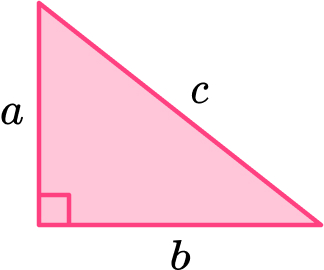
15 Pythagoras Theorem Practice Problems
Wish you could have the 15 Pythagoras Theorem questions from this blog in a ready-to-go worksheet? We've done just that!
1 – Label the sides of the triangle a , b , and c . Note that the hypotenuse, the longest side of a right triangle, is opposite the right angle and will always be labeled .
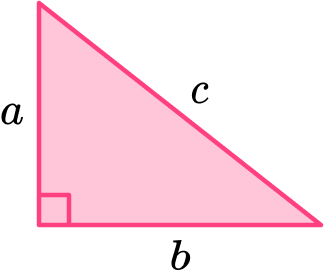
2 – Write down the formula and substitute the values>
3 – Calculate the answer. You may be asked to give your answer in an exact form or round to a given degree of accuracy, such as a certain number of decimal places or significant figures.
Pythagorean Theorem has many real-life uses, including in architecture and construction, navigation and surveying.
Pythagorean Theorem is usually introduced in middle school, as it is a part of the 8th grade Common Core Math Standards.
The emphasis in middle school is on students being able to:
- Explain the Pythagorean Theorem;
- Use the theorem to solve mathematical and real-world problems – with both 2D and 3D figures;
- Use the theorem to calculate the distance between two points on a coordinate grid.
The process for solving any Pythagoras Theorem problem always begins by identifying the relevant right-angled triangle and labeling the sides a , b , c. If there is not a diagram in the question, it can be helpful to draw one.
Where necessary, round your answers to 3 significant figures.
1. A ship sails 6 \, km East and then 8 \, km North. Find the ship’s distance from its starting point.
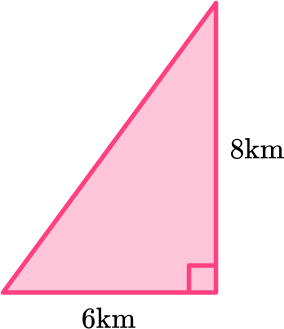
The ship is 10 kilometers from its starting point.
2. A ladder is 5 \, m long. The base of the ladder is 3 \, m from the base of a vertical wall. How far up the wall does the ladder reach?
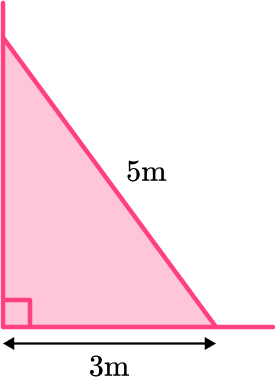
The ladder reaches 4 meters up the wall.
3. Alex and Sam start from the same point. Alex walks 400 meters west. Sam walks x meters south, until they are 600 \, m apart from each other. How far does Sam walk?
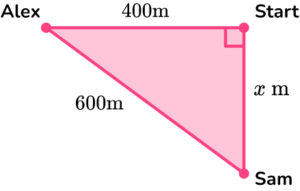
4. A television’s size is the measurement from the upper left hand corner of the television to the bottom right hand corner. Find the size of this television.
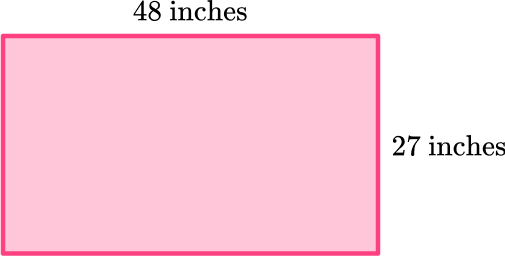
39.7 inches
55.1 inches
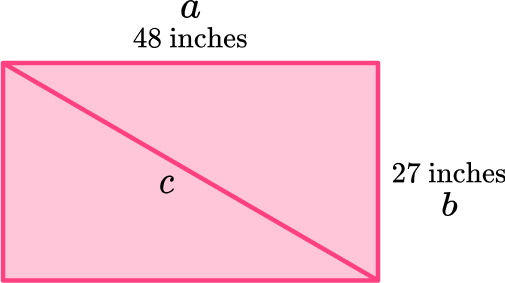
5. The pole of a sailing boat is supported by a rope from the top of the pole to an anchor point on the deck. The pole is 4 \, m long and the rope is 4.5 \, m long. Calculate the distance from the base of the pole to the anchor point of the rope on the deck.
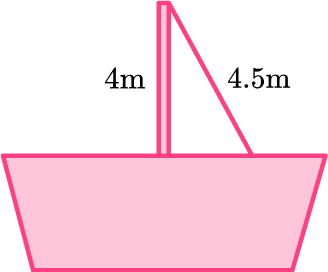
6. Work out the length of the diagonal of a square with 8 \, cm sides.
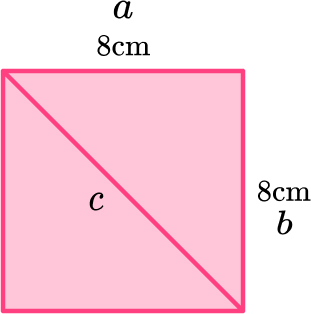
The diagonal of the square has a length of 11.3 centimeters.
7. ABC is an isosceles triangle.
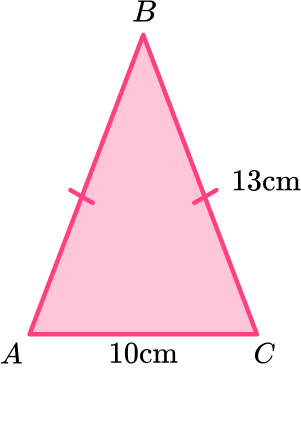
Work out the height of the triangle.
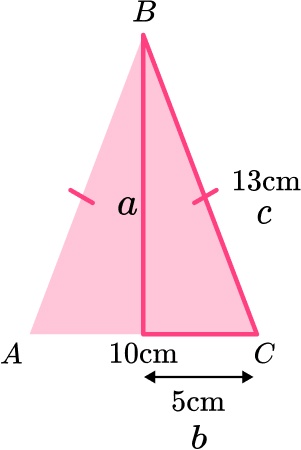
8. ABCD is an isosceles trapezoid.
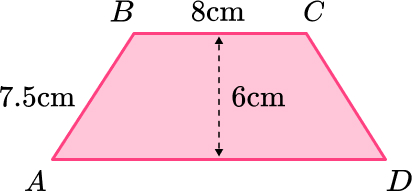
Work out the length of AD.
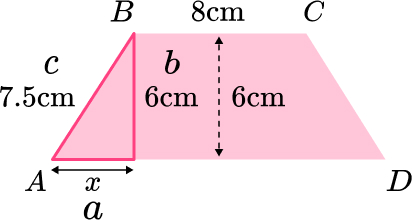
9. Here is a cm square grid. Calculate the distance between the points A and B.
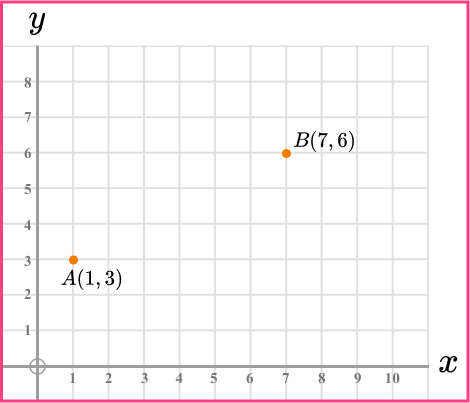
10. Which is a right angled triangle?
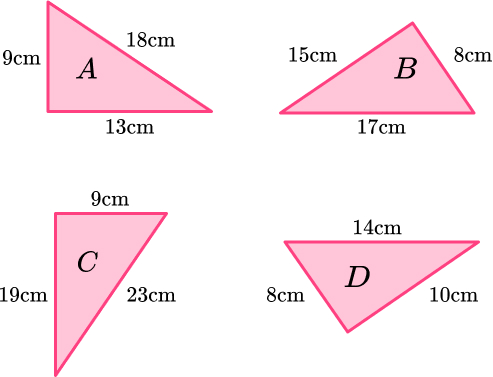
Not a right angled triangle because Pythagorean Theorem doesn’t work.
Right angled triangle because Pythagorean Theorem works.
11. PQRS is made from two right angled triangles.
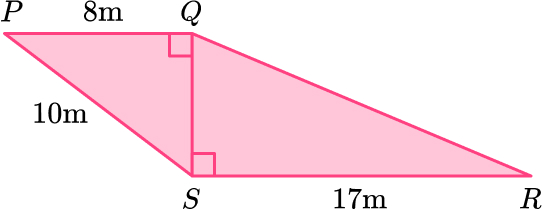
Work out the length of QR.
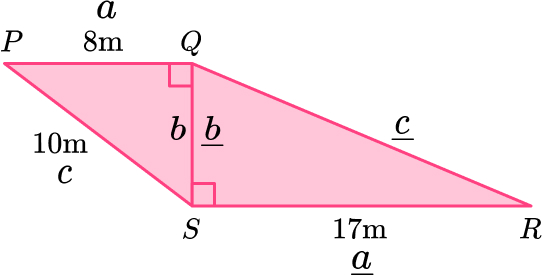
Triangle \text{PQS:}
Triangle \text{QRS}
12. Here is a pattern made from right angled triangles. Work out the length x.
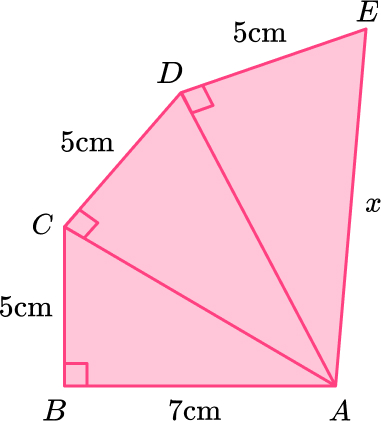
Triangle \text{ABC:}
Triangle \text{ACD:}
13. Here is a pyramid.
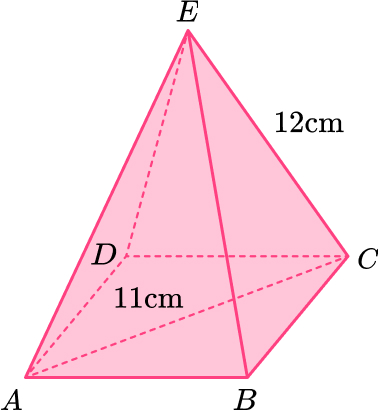
Work out the height of the pyramid.
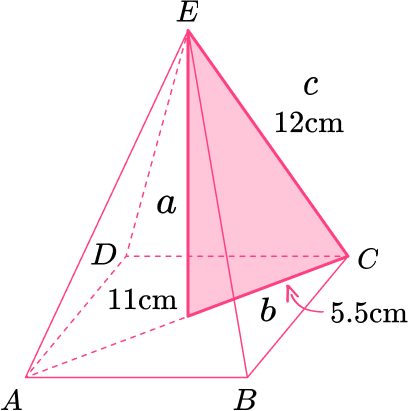
14. Here is a cuboid.
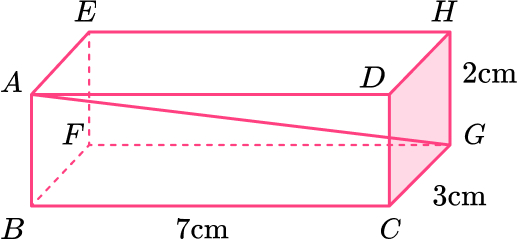
Work out the length AG.
Give your answer in its exact form.
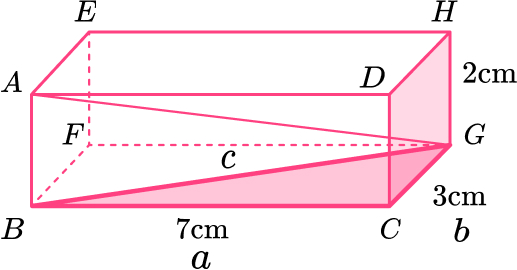
Length of \text{BG:}
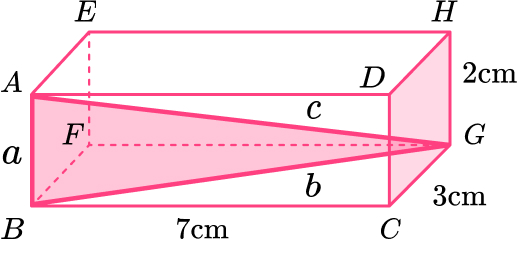
Length of \text{AG:}
15. Here is a right angled triangle.
Form an equation and use it to work out the value of x.
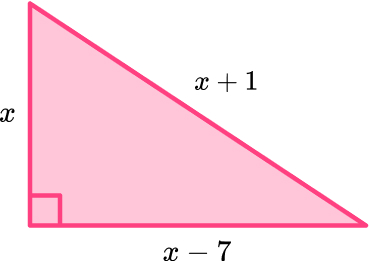
x=4 \, or \, x=12
x cannot be 4 as you can’t have a negative side length so x=12
In middle school, students…
- prove the Pythagorean Theorem;
- use the Pythagorean Theorem with trigonometric ratios to solve problems;
- use the Pythagorean Theorem in proofs.
Pythagoras Theorem may feature in questions alongside other topics, such as trigonometry, circle theorems or algebra.
The Pythagorean Theorem is used to calculate a missing length in a right triangle . If you have a right angled triangle and you know two of the lengths, label the sides of the triangle a,b and c (c must be the hypotenuse – the longest side). Pythagorean Theorem is a^2+b^2=c^2. Substitute the values you know into Pythagorean Theorem and solve to find the missing side.
The hypotenuse of a right triangle is the longest side. If you know the lengths of the other two sides, you can find the length of the hypotenuse by squaring the two shorter sides, adding those values together and then taking the square root. By doing this you are finding c in a^2+b^2=c^2
If your triangle is a right triangle and you know two of the sides, you can use Pythagorean Theorem to find the length of the third side. To do this, label the sides a , b and c (with c being the hypotenuse – the longest side). Substitute the values you know into a^2+b^2=c^2 and solve to find the missing side.
Looking for more Pythagorean theorem math questions?
- Ratio questions
- Algebra questions
- Probability questions
- Trigonometry questions
- Venn diagram questions
- Long division questions
Do you have students who need extra support in math? Give your students more opportunities to consolidate learning and practice skills through personalized math tutoring with their own dedicated online math tutor. Each student receives differentiated instruction designed to close their individual learning gaps, and scaffolded learning ensures every student learns at the right pace. Lessons are aligned with your state’s standards and assessments, plus you’ll receive regular reports every step of the way. Personalized one-on-one math tutoring programs are available for: – 2nd grade tutoring – 3rd grade tutoring – 4th grade tutoring – 5th grade tutoring – 6th grade tutoring – 7th grade tutoring – 8th grade tutoring Why not learn more about how it works ?
The content in this article was originally written by former UK Secondary teacher Beki Christian and has since been revised and adapted for US schools by elementary and middle school teacher Kathleen Epperson.
Math Games for 6th Graders [FREE]
On the lookout to make your math lessons fun and interactive while building math skills? Try our 6 printable math games for 6th graders.
Playable in pairs, teams or a whole class, our accompanying instructions and printable resources make preparation a breeze!
Privacy Overview
Pythagorean Theorem Word Problems
In these lessons, we will be looking at how to solve different types of word problems using the Pythagorean Theorem.
Related Pages Pythagorean Theorem Converse Of Pythagorean Theorem Applications Of Pythagorean Theorem More Geometry Lessons
How To Solve Word Problems Using The Pythagorean Theorem?
- Determine whether the word problem can be modeled by a right triangle.
- Use the Pythagorean Theorem to find the missing side if you are given two sides.
Example: Shane marched 3 m east and 6 m north. How far is he from his starting point?
Solution: First, sketch the scenario. The path taken by Shane forms a right-angled triangle. The distance from the starting point forms the hypotenuse.
Example: The rectangle PQRS represents the floor of a room.
Ivan stands at point A. Calculate the distance of Ivan from a) the corner R of the room b) the corner S of the room
Example: In the following diagram of a circle, O is the centre and the radius is 12 cm. AB and EF are straight lines.
Find the length of EF if the length of OP is 6 cm.
Examples Of Real Life Pythagorean Theorem Word Problems
Problem 1: A 35-foot ladder is leaning against the side of a building and is positioned such that the base of the ladder is 21 feet from the base of the building. How far above the ground is the point where the ladder touches the building?
Problem 2: The main mast of a fishing boat is supported by a sturdy rope that extends from the top of the mast to the deck. If the mast is 20 feet tall and the rope attached to the deck 15 feet away from the base of the mast, how long is the rope?
Problem 3: If an equilateral triangle has a height of 8, find the length of each side.
Problem 4: Two cyclist start from the same location. One cyclist travels due north and the other due east, at the same speed. Find the speed of each in miles per hour if after two hours they are 17sqrt(2) miles apart.
Problem 5: Two cars start from the same intersection with one traveling southbound while the other travels eastbound going 10 mph faster. If after two hours they are 10sqrt(34) apart, how fast was each car traveling?
Problem 6: A carpet measures 7 feet long and has a diagonal measurement of sqrt(74) feet. Find the width of the carpet.
Problem 7: Jim and Eileen decided to take a short cut through the woods to go to their friend’s house. When they went home they decided to take the long way around the woods to avoid getting muddy shoes. What total distance did they walk to and from their friend’s house? Dimensions are in meters.
Problem 8: Shari went to a level field to fly a kite. She let out all 650 feet of the string and tied it to a stake. Then, she walked out on the field until she was directly under the kite, which was 600 feet from the stake. How high was the kite from the ground?

We welcome your feedback, comments and questions about this site or page. Please submit your feedback or enquiries via our Feedback page.

IMAGES
VIDEO
COMMENTS
Here's the Pythagorean Theorem formula for your quick reference. Note: drawings not to scale. Problem 1: Find the value of [latex]x [/latex] in the right triangle. Problem 2: Find the value of [latex]x [/latex] in the right triangle. Problem 3: Find the value of [latex]x [/latex] in the right triangle. Problem 4: The legs of a right triangle ...
Learn. Test your understanding of Pythagorean theorem with these NaN questions. The Pythagorean theorem describes a special relationship between the sides of a right triangle. Even the ancients knew of this relationship. In this topic, we'll figure out how to use the Pythagorean theorem and prove why it works.
Example 2 (solving for a Leg) Use the Pythagorean theorem to determine the length of X. Step 1. Identify the legs and the hypotenuse of the right triangle . The legs have length 24 and X X are the legs. The hypotenuse is 26. Step 2. Substitute values into the formula (remember 'C' is the hypotenuse). A2 + B2 = C2 x2 + 242 = 262 A 2 + B 2 = C 2 ...
Examples of Applying the Pythagorean Theorem. Example 1: Find the length of the hypotenuse. Our goal is to solve for the length of the hypotenuse. We are given the lengths of the two legs. We know two sides out of the three! This is enough information for the formula to work.
Pythagorean theorem word problem: fishing boat. Video 3 minutes 3:00. Pythagorean theorem word problem: carpet. Video 10 minutes 46 seconds 10:46. Intro to the Pythagorean theorem. ... Learn for free about math, art, computer programming, economics, physics, chemistry, biology, medicine, finance, history, and more. Khan Academy is a nonprofit ...
About. Transcript. The Pythagorean theorem is a cornerstone of math that helps us find the missing side length of a right triangle. In a right triangle with sides A, B, and hypotenuse C, the theorem states that A² + B² = C². The hypotenuse is the longest side, opposite the right angle. Created by Sal Khan.
Pythagorean theorem. The equation for the Pythagorean theorem is. a 2 + b 2 = c 2. where a and b are the lengths of the two legs of the triangle, and c is the length of the hypotenuse. How can I tell which side is the hypotenuse? Want to learn more about the Pythagorean theorem?
The hypotenuse is the longest side of the right triangle. It is located directly opposite the right angle of the triangle. Most importantly, it is the quantity that is isolated by itself in the Pythagorean Theorem (Equation 7.4.1 ). Always isolate the quantity representing the hypotenuse on one side of the equation.
Pythagorean Theorem. The Pythagorean Theorem states that for a right triangle with legs of length and and hypotenuse of length we have the relationship . This theorem has been know since antiquity and is a classic to prove; hundreds of proofs have been published and many can be demonstrated entirely visually (the book The Pythagorean ...
How to Solve the Pythagorean Theorem - Example Problems. For example, find the hypotenuse of a right triangle with side that have lengths of 5 and 12. Start with the formula for the Pythagorean theorem and plug in the numbers for the sides a and b to solve for c. a 2 + b 2 = c 2 5 2 + 12 2 = c 2 c 2 = 5 2 + 12 2 = 25 + 144 = 169 c2 = 169 c ...
Using the Pythagorean Theorem to Solve Problems. Learning Outcomes. Use the pythagorean theorem to find the unknown length of a right triangle given the two other lengths; The Pythagorean Theorem is a special property of right triangles that has been used since ancient times. It is named after the Greek philosopher and mathematician Pythagoras ...
Using the Pythagorean Theorem to Solve Problems. Learning Outcomes. Use the pythagorean theorem to find the unknown length of a right triangle given the two other lengths The Pythagorean Theorem is a special property of right triangles that has been used since ancient times. It is named after the Greek philosopher and mathematician Pythagoras ...
Examples of using the Pythagorean theorem; Solving applied problems (word problems) Solving algebraic problems; Summary [adsenseWide] Applying the Pythagorean theorem (examples) In the examples below, we will see how to apply this rule to find any side of a right triangle triangle. As in the formula below, we will let a and b be the lengths of ...
Step by step guide to solve Pythagorean Theorem problems. We can use the Pythagorean Theorem to find a missing side in a right triangle. In any right triangle: \(\color{blue}{a^2+b^2= c^2}\) The Pythagorean Theorem . The Absolute Best Books to Ace Pre-Algebra to Algebra II.
In this concept, you will learn how to solve equations using the Pythagorean Theorem. ... Write an equation using the Pythagorean Theorem and solve each problem. Joanna laid a plank of wood down to make a ramp so that she could roll a wheelbarrow over a low wall in her garden. The wall is 1.5 meters tall, and the plank of wood touches the ...
In geometry, the Pythagorean theorem is mainly used to determine the lengths of the sides of a right triangle. Additionally, this theorem is used to derive other important formulas such as Pythagorean identities. Here, we will briefly review the Pythagorean theorem. We will look at its formula and we will apply it to solve some exercises.
Solution to Problem 2. We use the converse of the Pythagorean theorem to solve this problem. a) (2 , 3 , 4) : 4 is the length of the longest side. 2 2 + 3 2 = 13. 4 2 = 16. since 2 2 + 3 2 is NOT EQUAL to 4 2, (2 , 3 , 4) are not the lengths of the sides of a right triangle. b) (12 , 16 , 20) : 20 is the longest side.
It is called "Pythagoras' Theorem" and can be written in one short equation: a 2 + b 2 = c 2. Note: c is the longest side of the triangle; a and b are the other two sides; Definition. The longest side of the triangle is called the "hypotenuse", so the formal definition is:
How to answer Pythagorean Theorem questions. 1 - Label the sides of the triangle a, b, and c. Note that the hypotenuse, the longest side of a right triangle, is opposite the right angle and will always be labeled. 2 - Write down the formula and substitute the values>. a^2+b^2=c^2 a2 + b2 = c2. 3 - Calculate the answer.
a) d) 8) A right triangle has legs of 52.6 cm and 35.7 cm. Determine the length of the triangle's hypotenuse. 9) A right triangle has a hypotenuse of 152.6 m. The length of one of the other sides is 89.4 m. Determine the length of the third side. 10) For each of the following, the side lengths of a triangle are given.
Solution: OE is the radius of the circle, which is 12 cm. OP 2 + PE 2 = OE 2. 6 2 + PE 2 = 12 2. PE =. EF = 2 × PE = 20.78 cm. Examples Of Real Life Pythagorean Theorem Word Problems. Problem 1: A 35-foot ladder is leaning against the side of a building and is positioned such that the base of the ladder is 21 feet from the base of the building ...
Pythagorean theorem example. The Pythagorean theorem states that in a right triangle, the sum of the squares of the two shorter sides equals the square of the longest side (the hypotenuse). We can apply the theorem to find the missing side length of a right triangle, even when the missing length is one of the shorter sides.
Learn for free about math, art, computer programming, economics, physics, chemistry, biology, medicine, finance, history, and more. Khan Academy is a nonprofit with the mission of providing a free, world-class education for anyone, anywhere. ... In terms of "acceptable formats" for problem solving of Pythagorean Theorem is it possible to allow ...